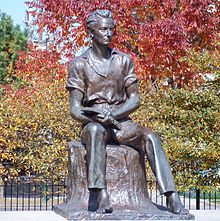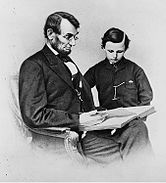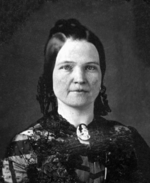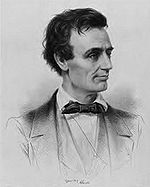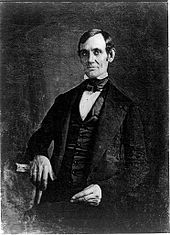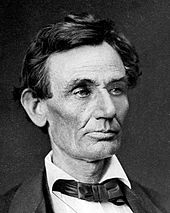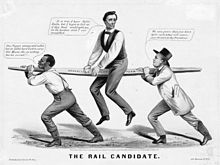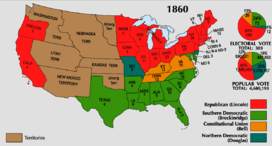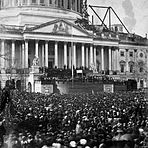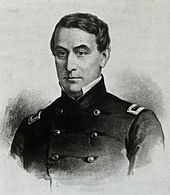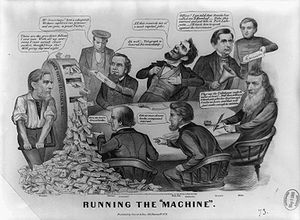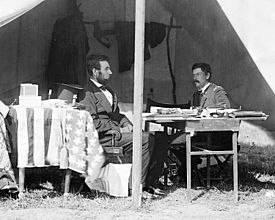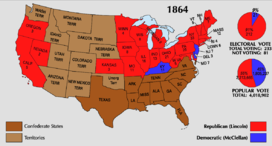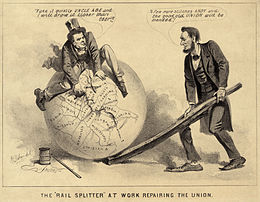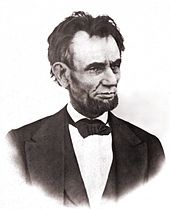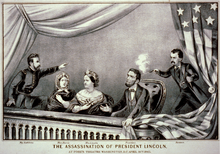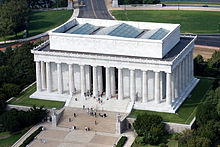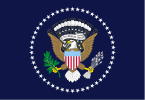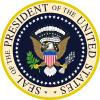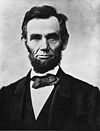- Abraham Lincoln
-
This article is about the American president. For other uses, see Abraham Lincoln (disambiguation).
Abraham Lincoln 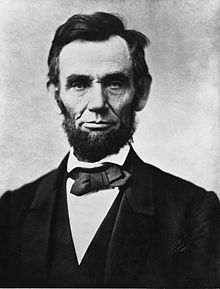
16th President of the United States In office
March 4, 1861 – April 15, 1865Vice President Hannibal Hamlin
Andrew JohnsonPreceded by James Buchanan Succeeded by Andrew Johnson Member of the U.S. House of Representatives
from Illinois's 7th districtIn office
March 4, 1847 – March 3, 1849Preceded by John Henry Succeeded by Thomas Harris Personal details Born February 12, 1809
Hodgenville, Kentucky, U.S.Died April 15, 1865 (aged 56)
Washington, D.C., U.S.Political party Republican Party (1854–1865)
National Union Party (1864–1865)Other political
affiliationsWhig Party (Before 1854) Spouse(s) Mary Todd Children Robert
Edward
William
TadProfession Lawyer Religion See article Signature 
Military service Service/branch Illinois Militia Years of service 1832 Battles/wars Black Hawk War Abraham Lincoln
 i/ˈeɪbrəhæm ˈlɪŋkən/ (February 12, 1809 – April 15, 1865) was the 16th President of the United States, serving from March 1861 until his assassination in 1865. He led the country through a great constitutional, military and moral crisis – the American Civil War – preserving the Union, while ending slavery, and promoting economic and financial modernization. Reared in a poor family on the western frontier, Lincoln was mostly self-educated. He became a country lawyer, an Illinois state legislator, and a one-term member of the United States House of Representatives, but failed in two attempts at a seat in the United States Senate.
i/ˈeɪbrəhæm ˈlɪŋkən/ (February 12, 1809 – April 15, 1865) was the 16th President of the United States, serving from March 1861 until his assassination in 1865. He led the country through a great constitutional, military and moral crisis – the American Civil War – preserving the Union, while ending slavery, and promoting economic and financial modernization. Reared in a poor family on the western frontier, Lincoln was mostly self-educated. He became a country lawyer, an Illinois state legislator, and a one-term member of the United States House of Representatives, but failed in two attempts at a seat in the United States Senate.After opposing the expansion of slavery in the United States in his campaign debates and speeches,[1] Lincoln secured the Republican nomination and was elected president in 1860. Following declarations of secession by southern slave states, war began in April 1861, and he concentrated on both the military and political dimensions of the war effort, seeking to reunify the nation. He vigorously exercised unprecedented war powers, including the arrest and detention without trial of thousands of suspected secessionists. He prevented British recognition of the Confederacy by skillfully handling the Trent affair late in 1861. He issued his Emancipation Proclamation in 1863 and promoted the passage of the Thirteenth Amendment to the United States Constitution, abolishing slavery.
Lincoln closely supervised the war effort, especially the selection of top generals, including commanding general Ulysses S. Grant. He brought leaders of various factions of his party into his cabinet and pressured them to cooperate. Under his leadership, the Union set up a naval blockade that shut down the South's normal trade, took control of the border slave states at the start of the war, gained control communications with gunboats on the southern river systems, and tried repeatedly to capture the Confederate capital at Richmond. Each time a general failed, Lincoln substituted another until finally Grant succeeded in 1865. An exceptionally astute politician deeply involved with power issues in each state, he reached out to War Democrats and managed his own re-election in the 1864 presidential election.
As the leader of the moderate faction of the Republican party, Lincoln's policies and personality were "blasted from all sides": Radical Republicans demanded harsher treatment of the South, War Democrats desired more compromise, Copperheads despised him, and irreconcilable secessionists plotted his death.[2] Politically, Lincoln fought back with patronage, by pitting his opponents against each other, and by appealing to the American people with his powers of oratory.[3] His Gettysburg Address of 1863 became the most quoted speech in American history.[4] It was an iconic statement of America's dedication to the principles of nationalism, equal rights, liberty, and democracy. At the close of the war, Lincoln held a moderate view of Reconstruction, seeking to speedily reunite the nation through a policy of generous reconciliation in the face of lingering and bitter divisiveness. However, just six days after the surrender of Confederate commanding general Robert E. Lee, Lincoln was shot and killed by Confederate sympathizer John Wilkes Booth at Ford's Theatre in Washington, D.C. His death marked the first assassination of a U.S. president. Lincoln has been consistently ranked by scholars as one of the greatest U.S. presidents.
Family and childhood
Early life
Main article: Early life and career of Abraham LincolnAbraham Lincoln was born February 12, 1809, the second child of Thomas Lincoln and Nancy Lincoln (née Hanks), in a one-room log cabin on the Sinking Spring Farm in Hardin County, Kentucky,[5] (now LaRue County). Lincoln's paternal grandfather and namesake, Abraham, had moved his family from Virginia to Jefferson County, Kentucky,[6][7] where he was ambushed and killed in an Indian raid in 1786, with his children, including Lincoln's father Thomas, looking on.[7] Thomas was left to make his own way on the frontier.[8] Lincoln's mother, Nancy, was the daughter of Lucy Hanks, and was born in what is now Mineral County, West Virginia, then part of Virginia. Lucy moved with Nancy to Kentucky. Nancy Hanks married Thomas, who became a respected citizen. He bought and sold several farms, including the Sinking Spring Farm. The family attended a Separate Baptists church, which had high moral standards and opposed alcohol, dancing, and slavery.[9] Thomas enjoyed considerable status in Kentucky—where he sat on juries, appraised estates, served on country slave patrols, and guarded prisoners. By the time his son Abraham was born, Thomas owned two 600-acre (240 ha) farms, several town lots, livestock, and horses. He was among the richest men in the county.[6][10] However, in 1816, Thomas lost all of his land in court cases because of faulty property titles.[11]
The family moved north across the Ohio River to free (i.e., non-slave) territory and made a new start in Perry County, Indiana. Lincoln later noted that this move was "partly on account of slavery" but mainly due to land title difficulties.[11] In Indiana, when Lincoln was nine, his mother Nancy died of milk sickness in 1818.[12] After the death of Lincoln's mother, his older sister, Sarah, took charge of caring for him until their father remarried in 1819; Sarah later died in her 20s while giving birth to a stillborn son.[13]
Thomas Lincoln's new wife was the widow Sarah Bush Johnston, the mother of three of her own children. Lincoln became very close to his stepmother, and referred to her as "Mother".[14] As a pre-teen, he did not like the hard labor associated with frontier life. Some in his family, and in the neighborhood, for a time considered him to be lazy.[15][16] As he grew into his teens, he willingly took responsibility for all chores expected of him as one of the boys in the household and became an adept axeman in his work building rail fences. He attained a reputation for brawn and audacity after a very competitive wrestling match to which he was challenged by the renowned leader of a group of ruffians, "the Clary's Grove boys".[17] Lincoln also agreed with the customary obligation of a son to give his father all earnings from work done outside the home until age 21.[12] In later years, Lincoln occasionally loaned his father money.[18] Lincoln became increasingly distant from his father, in part because of his father's lack of education. While young Lincoln's formal elementary education consisted approximately of a years worth of classes from several itinerant teachers, he was mostly self-educated and was an avid reader.[19]
In 1830, fearing a milk sickness outbreak along the Ohio River, the Lincoln family moved west, where they settled on public land in Macon County, Illinois, another free, non-slave state.[20] In 1831, Thomas relocated the family to a new homestead in Coles County, Illinois. It was then that as an ambitious 22-year-old, Lincoln decided to seek a better life and struck out on his own. Canoeing down the Sangamon River, Lincoln ended up in the village of New Salem in Sangamon County.[21] In the spring of 1831, hired by New Salem businessman Denton Offutt and accompanied by friends, he took goods by flatboat from New Salem to New Orleans via the Sangamon, Illinois, and Mississippi rivers. After arriving in New Orleans—and witnessing slavery firsthand—he walked back home.[22]
Marriage and children
Further information: Lincoln family tree, Medical and mental health of Abraham Lincoln, and Sexuality of Abraham LincolnLincoln's first romantic interest was Ann Rutledge, whom he met when he first moved to New Salem; by 1835, they were in a relationship but not formally engaged. She died, however, on August 25, most likely of typhoid fever.[23] In the early 1830s, he met Mary Owens from Kentucky when she was visiting her sister. Late in 1836, Lincoln agreed to a match with Mary if she returned to New Salem. Mary did return in November 1836, and Lincoln courted her for a time; however, they both had second thoughts about their relationship. On August 16, 1837, Lincoln wrote Mary a letter suggesting he would not blame her if she ended the relationship. She never replied and the courtship was over.[24]
In 1840, Lincoln became engaged to Mary Todd, who was from a wealthy slave-holding family in Lexington, Kentucky.[25] They met in Springfield, Illinois, in December 1839[26] and were engaged the following December.[27] A wedding set for January 1, 1841 was canceled when the two broke off their engagement at Lincoln's initiative.[26][28] They later met at a party and were married on November 4, 1842, in the Springfield mansion of Mary's married sister.[29] While preparing for the nuptials and feeling reluctance again, Lincoln, when asked where he was going, replied, "To hell, I suppose."[30]
In 1844, the couple bought a house in Springfield near Lincoln's law office.[31] Mary Todd Lincoln worked diligently in their home, assuming full household duties which had previously been performed for her in her own family in Kentucky. She also made efficient use of the limited funds available from her husband's law practice.[32] Robert Todd Lincoln was born in 1843 and Edward Baker Lincoln (Eddie) in 1846. Lincoln "was remarkably fond of children",[33] and the Lincolns were not considered to be strict with their children.[34] Robert was the only child to live to adulthood. Edward died on February 1, 1850, in Springfield, likely of tuberculosis. "Willie" Lincoln was born on December 21, 1850 and died on February 20, 1862. The Lincolns' fourth son, Thomas "Tad" Lincoln, was born on April 4, 1853 and died of heart failure at the age of 18 on July 16, 1871.[35]
The death of their sons had profound effects on both parents. Later in life, Mary struggled with the stresses of losing her husband and sons, and Robert Lincoln committed her temporarily to a mental health asylum in 1875.[36] Abraham Lincoln suffered from "melancholy", a condition which now may be referred to as clinical depression.[37]
Lincoln's father-in-law was based in Lexington, Kentucky; he and others of the Todd family were either slave owners or slave traders. Lincoln was close to the Todds, and he and his family occasionally visited the Todd estate in Lexington.[38] He was an affectionate, though often absent, husband and father of four children.
Early career and militia service
Main articles: Early life and career of Abraham Lincoln and Abraham Lincoln in the Black Hawk WarIn 1832, at age 23, Lincoln and a partner bought a small general store on credit in New Salem, Illinois. Although the economy was booming in the region, the business struggled and Lincoln eventually sold his share. That March he began his political career with his first campaign for the Illinois General Assembly. He had attained local popularity and could draw crowds as a natural raconteur in New Salem, though he lacked an education, powerful friends, and money, which may be why he lost. He advocated navigational improvements on the Sangamon River.[39]
Before the election Lincoln served as a captain in the Illinois Militia during the Black Hawk War.[40] Following his return, Lincoln continued his campaign for the August 6 election for the Illinois General Assembly. At 6 feet 4 inches (193 cm),[41] he was tall and "strong enough to intimidate any rival". At his first speech, when he saw a supporter in the crowd being attacked, Lincoln grabbed the assailant by his "neck and the seat of his trousers" and threw him.[42] Lincoln finished eighth out of thirteen candidates (the top four were elected), though he received 277 of the 300 votes cast in the New Salem precinct.[43]
Lincoln served as New Salem's postmaster and later as county surveyor, all the while reading voraciously. He then decided to become a lawyer and began teaching himself law by reading Blackstone's Commentaries on the Laws of England and other law books. Of his learning method, Lincoln stated: "I studied with nobody".[44] His second campaign in 1834 was successful. He won election to the state legislature; though he ran as a Whig, many Democrats favored him over a more powerful Whig opponent.[45] Admitted to the bar in 1836,[46] he moved to Springfield, Illinois, and began to practice law under John T. Stuart, Mary Todd's cousin.[47] Lincoln became an able and successful lawyer with a reputation as a formidable adversary during cross-examinations and closing arguments. He partnered with Stephen T. Logan from 1841 until 1844, when he began his practice with William Herndon, whom Lincoln thought "a studious young man".[48] He served four successive terms in the Illinois House of Representatives as a Whig representative from Sangamon County.[49]
In the 1835–1836 legislative session, he voted to expand suffrage to white males, whether landowners or not.[50] He was known for his "free soil" stance of opposing both slavery and abolitionism. He first articulated this in 1837, saying, "Institution of slavery is founded on both injustice and bad policy, but the promulgation of abolition doctrines tends rather to increase than abate its evils."[51] He closely followed Henry Clay in supporting the American Colonization Society program of making the abolition of slavery practical by helping the freed slaves to settle in Liberia in Africa.[52]
Congressman Lincoln
From the early 1830s, Lincoln was a steadfast Whig and professed to friends in 1861 to be, "an old line Whig, a disciple of Henry Clay".[53] The party, including Lincoln, favored economic modernization in banking, railroads, and internal improvements and espoused urbanization as well as protective tariffs.[54]
In 1846, Lincoln was elected to the U.S. House of Representatives, where he served one two-year term. He was the only Whig in the Illinois delegation, but he showed his party loyalty by participating in almost all votes and making speeches that echoed the party line.[55] Lincoln, in collaboration with abolitionist Congressman Joshua R. Giddings, wrote a bill to abolish slavery in the District of Columbia with compensation for the owners, enforcement to capture fugitive slaves, and a popular vote on the matter. He abandoned the bill when it failed to garner sufficient Whig supporters.[56] On foreign and military policy, Lincoln spoke out against the Mexican–American War, which he attributed to President Polk's desire for "military glory—that attractive rainbow, that rises in showers of blood".[57] Lincoln also supported the Wilmot Proviso, which, if it had been adopted, would have banned slavery in any U.S. territory won from Mexico.[58]
Lincoln emphasized his opposition to Polk by drafting and introducing his Spot Resolutions. The war had begun with a Mexican slaughter of American soldiers in territory disputed by Mexico and the US; Polk insisted that Mexican soldiers had "invaded our territory and shed the blood of our fellow-citizens on our own soil".[59][60] Lincoln demanded that Polk show Congress the exact spot on which blood had been shed and prove that the spot was on American soil.[60] Congress never enacted the resolution or even debated it, the national papers ignored it, and it resulted in a loss of political support for Lincoln in his district. One Illinois newspaper derisively nicknamed him "spotty Lincoln".[61][62][63] Lincoln later regretted some of his statements, especially his attack on the presidential war-making powers.[64]
Realizing Clay was unlikely to win the presidency, Lincoln, who had pledged in 1846 to serve only one term in the House, supported General Zachary Taylor for the Whig nomination in the 1848 presidential election.[65] Taylor won and Lincoln hoped to be appointed Commissioner of the General Land Office, but that lucrative patronage job went to an Illinois rival, Justin Butterfield, considered by the administration to be a highly skilled lawyer, but in Lincoln's view, an "old fossil".[66] The administration offered him the consolation prize of secretary or governor of the Oregon Territory. This distant territory was a Democratic stronghold, and acceptance of the post would have effectively ended his legal and political career in Illinois, so he declined and resumed his law practice.[67]
Prairie lawyer
Lincoln returned to practicing law in Springfield, handling "every kind of business that could come before a prairie lawyer".[68] Twice a year for sixteen years, ten weeks at a time, he appeared in county seats in the midstate region when the county courts were in session.[69] Lincoln handled many transportation cases in the midst of the nation's western expansion, particularly the conflicts arising from the operation of river barges under the many new railroad bridges. As a riverboat man, Lincoln initially favored those interests but ultimately represented whoever hired him.[70] His reputation grew, and he appeared before the Supreme Court of the United States, arguing a case involving a canal boat that sank after hitting a bridge.[71] In 1849, he received a patent for a flotation device for the movement of boats in shallow water. The idea was never commercialized, but Lincoln is the only president to hold a patent.[72][73]
In 1851, he represented Alton & Sangamon Railroad in a dispute with one of its shareholders, James A. Barret, who had refused to pay the balance on his pledge to buy shares in the railroad on the grounds that the company had changed its original train route.[74][75] Lincoln successfully argued that the railroad company was not bound by its original charter in existence at the time of Barret's pledge; the charter was amended in the public interest to provide a newer, superior, and less expensive route, and the corporation retained the right to demand Barret's payment. The decision by the Illinois Supreme Court has been cited by numerous other courts in the nation.[74] Lincoln appeared before the Illinois Supreme Court in 175 cases, in 51 as sole counsel, of which 31 were decided in his favor.[76] From 1853 to 1860, another of Lincoln's largest clients was the Illinois Central Railroad.[77]
Lincoln's most notable criminal trial occurred in 1858 when he defended William "Duff" Armstrong, who was on trial for the murder of James Preston Metzker.[78] The case is famous for Lincoln's use of a fact established by judicial notice in order to challenge the credibility of an eyewitness. After an opposing witness testified seeing the crime in the moonlight, Lincoln produced a Farmers' Almanac showing the moon was at a low angle, drastically reducing visibility. Based on this evidence, Armstrong was acquitted.[78] Lincoln rarely raised objections in the courtroom; but in an 1859 case, where he defended a cousin Peachy Harrison, who was accused of stabbing another to death, Lincoln angrily protested the judge's decision to exclude evidence favorable to his client. Instead of holding Lincoln in contempt of court as was expected, the judge, a Democrat, reversed his ruling, allowing the evidence and acquitting Harrison.[78][79]
Republican politics 1854–1860
Slavery and a "House Divided"
Further information: Slave and free states and Abraham Lincoln and slaveryBy the 1850s, slavery was still legal in the southern United States but had been generally outlawed in the northern states, such as Illinois.[80] Lincoln disapproved of slavery, and the spread of slavery to new U.S. territory in the west.[81] He returned to politics to oppose the pro-slavery Kansas–Nebraska Act (1854); this law repealed the slavery-restricting Missouri Compromise (1820). Senior Senator Stephen A. Douglas of Illinois had incorporated popular sovereignty into the Act. Douglas' provision, which Lincoln opposed, specified settlers had the right to determine locally whether to allow slavery in new U.S. territory, rather than have such a decision restricted by the national Congress.[82] Foner (2010) contrasts the abolitionists and anti-slavery Radical Republicans of the Northeast who saw slavery as a sin, with the conservative Republicans who thought it was bad because it hurt white people and blocked progress. Foner argues that Lincoln was a moderate in the middle, opposing slavery primarily because it violated the republicanism principles of the Founding Fathers, especially the equality of all men and democratic self-government as expressed in the Declaration of Independence.[83]
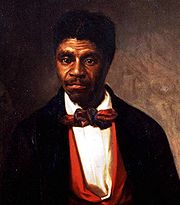 Portrait of Dred Scott. Lincoln denounced the Supreme Court decision in Dred Scott v. Sandford as a conspiracy.
Portrait of Dred Scott. Lincoln denounced the Supreme Court decision in Dred Scott v. Sandford as a conspiracy.
On October 16, 1854, in his "Peoria Speech", Lincoln declared his opposition to slavery, which he repeated en route to the presidency.[84] Speaking in his Kentucky accent, with a very powerful voice,[85] he said the Kansas Act had a "declared indifference, but as I must think, a covert real zeal for the spread of slavery. I cannot but hate it. I hate it because of the monstrous injustice of slavery itself. I hate it because it deprives our republican example of its just influence in the world..."[86]
In late 1854, Lincoln ran as a Whig for the U.S. Senate seat from Illinois. At that time, senators were elected by the state legislature.[87] After leading in the first six rounds of voting in the Illinois assembly, his support began to dwindle, and Lincoln instructed his backers to vote for Lyman Trumbull, who defeated opponent Joel Aldrich Matteson.[88] The Whigs had been irreparably split by the Kansas–Nebraska Act. Lincoln wrote, "I think I am a Whig, but others say there are no Whigs, and that I am an abolitionist, even though I do no more than oppose the extension of slavery." Drawing on remnants of the old Whig party, and on disenchanted Free Soil, Liberty, and Democratic party members, he was instrumental in forging the shape of the new Republican Party.[89] At the Republican convention in 1856, Lincoln placed second in the contest to become the party's candidate for vice president.[90]
In 1857–58, Douglas broke with President James Buchanan, leading to a fight for control of the Democratic Party. Some eastern Republicans even favored the reelection of Douglas for the Senate in 1858, since he had led the opposition to the Lecompton Constitution, which would have admitted Kansas as a slave state.[91] In March 1857, the Supreme Court issued its decision in Dred Scott v. Sandford; Chief Justice Roger B. Taney opined that blacks were not citizens, and derived no rights from the Constitution. Lincoln denounced the decision, alleging it was the product of a conspiracy of Democrats to support the Slave Power[92] Lincoln argued, "The authors of the Declaration of Independence never intended 'to say all were equal in color, size, intellect, moral developments, or social capacity', but they 'did consider all men created equal—equal in certain inalienable rights, among which are life, liberty, and the pursuit of happiness'."[93]
After the state Republican party convention nominated him for the U.S. Senate in 1858, Lincoln delivered his House Divided Speech, drawing on Mark's gospel from the Bible: "A house divided against itself cannot stand. I believe this government cannot endure permanently half slave and half free. I do not expect the Union to be dissolved—I do not expect the house to fall—but I do expect it will cease to be divided. It will become all one thing, or all the other."[94] The speech created an evocative image of the danger of disunion caused by the slavery debate, and rallied Republicans across the North.[95] The stage was then set for the campaign for statewide election of the Illinois legislature which would, in turn, select Lincoln or Douglas as its U.S. senator.[96]
Lincoln–Douglas debates and Cooper Union speech
The 1858 senate campaign featured the seven Lincoln–Douglas debates of 1858, the most famous political debates in American history.[97] The principals stood in stark contrast both physically and politically. Lincoln warned that "The Slave Power" was threatening the values of republicanism, and accused Douglas of distorting the values of the Founding Fathers that all men are created equal, while Douglas emphasized his Freeport Doctrine, that local settlers were free to choose whether to allow slavery or not, and accused Lincoln of having joined the abolitionists.[98] The debates had an atmosphere of a prize fight and drew crowds in the thousands. Lincoln stated Douglas's popular sovereignty theory was a threat to the nation's morality and that Douglas represented a conspiracy to extend slavery to free states. Douglas said that Lincoln was defying the authority of the U.S. Supreme Court and the Dred Scott decision.[99]
Though the Republican legislative candidates won more popular votes, the Democrats won more seats, and the legislature re-elected Douglas to the Senate. Despite the bitterness of the defeat for Lincoln, his articulation of the issues gave him a national political reputation.[100] In May 1859, Lincoln purchased the Illinois Staats-Anzeiger, a German-language newspaper which was consistently supportive; most of the state's 130,000 German Americans voted Democratic but there was Republican support that a German-language paper could mobilize.[101]
On February 27, 1860, New York party leaders invited Lincoln to give a speech at Cooper Union to a group of powerful Republicans. Lincoln argued that the Founding Fathers had little use for popular sovereignty and had repeatedly sought to restrict slavery. Lincoln insisted the moral foundation of the Republicans required opposition to slavery, and rejected any "groping for some middle ground between the right and the wrong".[102] Despite his inelegant appearance—many in the audience thought him awkward and even ugly[103]—Lincoln demonstrated an intellectual leadership that brought him into the front ranks of the party and into contention for the Republican presidential nomination. Journalist Noah Brooks reported, "No man ever before made such an impression on his first appeal to a New York audience."[104][105] Donald described the speech as a "superb political move for an unannounced candidate, to appear in one rival's (William H. Seward) own state at an event sponsored by the second rival's (Salmon P. Chase) loyalists, while not mentioning either by name during its delivery."[106] In response to an inquiry about his presidential intentions, Lincoln said, "The taste is in my mouth a little."[107]
1860 Presidential nomination and campaign
Main articles: Electoral history of Abraham Lincoln and United States presidential election, 1860On May 9–10, 1860, the Illinois Republican State Convention was held in Decatur.[108] Lincoln's followers organized a campaign team led by David Davis, Norman Judd, Leonard Swett, and Jesse DuBois, and Lincoln received his first endorsement to run for the presidency.[109] Exploiting the embellished legend of his frontier days with his father, Lincoln's supporters adopted the label of "The Rail Candidate".[110] On May 18, at the Republican National Convention in Chicago, Lincoln's friends promised and manipulated and won the nomination on the third ballot, beating candidates such as William H. Seward and Salmon P. Chase. A former Democrat Hannibal Hamlin of Maine was nominated for Vice President to balance the ticket. Lincoln's success depended on his reputation as a moderate on the slavery issue, and his strong support for Whiggish programs of internal improvements and the protective tariff.[111] On the third ballot Pennsylvania put him over the top. Pennsylvania iron interests were reassured by his support for protective tariffs.[112] Lincoln's managers had been adroitly focused on this delegation as well as the others, while following Lincoln's strong dictate to "Make no contracts that bind me".[113]
Most Republicans agreed with Lincoln that the North was the aggrieved party, as the Slave Power tightened its grasp on the national government with the Dred Scott decision and the presidency of James Buchanan. Throughout the 1850s, Lincoln doubted the prospects of civil war, and his supporters rejected claims that his election would incite secession.[114] Meanwhile, Douglas was selected as the candidate of the Northern Democrats, with Herschel Vespasian Johnson as the vice-presidential candidate. Delegates from 11 slave states walked out of the Democratic convention, disagreeing with Douglas's position on popular sovereignty, and ultimately selected John C. Breckinridge as their candidate.[115]
As Douglas and the other candidates went through with their campaigns, Lincoln was the only one of them who gave no speeches. Instead, he monitored the campaign closely and relied on the enthusiasm of the Republican Party. The party did the leg work that produced majorities across the North, and produced an abundance of campaign posters, leaflets, and newspaper editorials. There were thousands of Republican speakers who focused first on the party platform, and second on Lincoln's life story, emphasizing his childhood poverty. The goal was to demonstrate the superior power of "free labor", whereby a common farm boy could work his way to the top by his own efforts.[116] The Republican Party's production of campaign literature dwarfed the combined opposition; a Chicago Tribune writer produced a pamphlet that detailed Lincoln's life, and sold 100,000 to 200,000 copies.[117]
Presidency
See also: Presidency of Abraham Lincoln1860 election and secession
Main articles: United States presidential election, 1860 and Baltimore PlotOn November 6, 1860, Lincoln was elected the sixteenth president of the United States, beating Democrat Stephen A. Douglas, John C. Breckinridge of the Southern Democrats, and John Bell of the new Constitutional Union Party. He was the first president from the Republican Party. Winning entirely on the strength of his support in the North and West, no ballots were cast for him in ten of the fifteen Southern slave states, and he won only two of 996 counties in all the Southern states.[118] Lincoln received 1,866,452 votes, Douglas 1,376,957 votes, Breckinridge 849,781 votes, and Bell 588,789 votes. Turnout was 82.2 percent, with Lincoln winning the free Northern states, as well as California and Oregon. Douglas won Missouri, and split New Jersey with Lincoln.[119] Bell won Virginia, Tennessee, and Kentucky, and Breckinridge won the rest of the South.[120] The States' Electoral votes were decisive: Lincoln had 180 and his opponents added together had only 123. There were fusion tickets in which all of Lincoln's opponents combined to support the same slate of Electors in New York, New Jersey, and Rhode Island, but even if the anti-Lincoln vote had been combined in every state, Lincoln still would have won a majority in the Electoral College.[121]
In 1860, northern and western electoral votes (shown in red) put Lincoln into the White House.As Lincoln's election became evident, secessionists made clear their intent to leave the Union before he took office the next March.[122] On December 20, 1860, South Carolina took the lead by adopting an ordinance of secession; by February 1, 1861, Florida, Mississippi, Alabama, Georgia, Louisiana, and Texas followed.[123][124] Six of these states then adopted a constitution and declared themselves to be a sovereign nation, the Confederate States of America.[123] The upper South and border states (Delaware, Maryland, Virginia, North Carolina, Tennessee, Kentucky, Missouri, and Arkansas) listened to, but initially rejected, the secessionist appeal.[125] President Buchanan and President-elect Lincoln refused to recognize the Confederacy, declaring secession illegal.[126] The Confederacy selected Jefferson Davis as their provisional President on February 9, 1861.[127]
There were attempts at compromise. The Crittenden Compromise would have extended the Missouri Compromise line of 1820, dividing the territories into slave and free, contrary to the Republican Party's free-soil platform.[128] Lincoln rejected the idea, saying, "I will suffer death before I consent ... to any concession or compromise which looks like buying the privilege to take possession of this government to which we have a constitutional right."[129] Lincoln, however, did support the Corwin Amendment to the Constitution, which had passed in Congress and protected slavery in those states where it already existed.[130] A few weeks before the war, he went so far as to pen a letter to every governor asking for their support in ratifying the Corwin Amendment as a means to avoid secession.[131]
En route to his inauguration by train, Lincoln addressed crowds and legislatures across the North.[132] The president-elect then evaded possible assassins in Baltimore, who were uncovered by Lincoln's head of security, Allan Pinkerton. On February 23, 1861, he arrived in disguise in Washington, D.C., which was placed under substantial military guard.[133] Lincoln directed his inaugural address to the South, proclaiming once again that he had no intention, or inclination, to abolish slavery in the Southern states:
Apprehension seems to exist among the people of the Southern States that by the accession of a Republican Administration their property and their peace and personal security are to be endangered. There has never been any reasonable cause for such apprehension. Indeed, the most ample evidence to the contrary has all the while existed and been open to their inspection. It is found in nearly all the published speeches of him who now addresses you. I do but quote from one of those speeches when I declare that "I have no purpose, directly or indirectly, to interfere with the institution of slavery in the States where it exists. I believe I have no lawful right to do so, and I have no inclination to do so."—First inaugural address, 4 March 1861[134]The President ended his address with an appeal to the people of the South: "We are not enemies, but friends. We must not be enemies ... The mystic chords of memory, stretching from every battlefield, and patriot grave, to every living heart and hearthstone, all over this broad land, will yet swell the chorus of the Union, when again touched, as surely they will be, by the better angels of our nature."[135] The failure of the Peace Conference of 1861 signaled that legislative compromise was implausible. By March 1861, no leaders of the insurrection had proposed rejoining the Union on any terms. Meanwhile, Lincoln and nearly every Republican leader agreed that the dismantling of the Union could not be tolerated.[136]
War begins
Main article: American Civil WarThe commander of Fort Sumter, South Carolina, Major Robert Anderson sent a request for provisions to Washington, and the execution of Lincoln's order to meet that request was seen by the secessionists as an act of war. On April 12, 1861, Confederate forces fired on Union troops at Fort Sumter, forcing them to surrender, and began the war. Historian Allan Nevins argued that the newly inaugurated Lincoln miscalculated in believing that he could preserve the Union,[137] and William Tecumseh Sherman, then a civilian, visited Lincoln in the White House during inauguration week and was "sadly disappointed" at Lincoln's seeming failure to realize that "the country was sleeping on a volcano" and that the South was preparing for war.[138] Donald concludes that, "His repeated efforts to avoid collision in the months between inauguration and the firing on Ft. Sumter showed he adhered to his vow not to be the first to shed fraternal blood. But he also vowed not to surrender the forts. The only resolution of these contradictory positions was for the confederates to fire the first shot; they did just that."[139]
On April 15, Lincoln called on all the states to send detachments totaling 75,000 troops to recapture forts, protect Washington, and "preserve the Union", which, in his view, still existed intact despite the actions of the seceding states. This call forced the states to choose sides. Virginia declared its secession and was rewarded with the Confederate capital, despite the exposed position of Richmond so close to Union lines. North Carolina, Tennessee, and Arkansas also voted for secession over the next two months. Secession sentiment was strong in Missouri and Maryland, but did not prevail; Kentucky tried to be neutral.[140]
Troops headed south towards Washington, to protect the capital in response to Lincoln's call. On April 19, secessionist mobs in Baltimore that controlled the rail links attacked Union troops traveling to the capital. George William Brown, the Mayor of Baltimore, and other suspect Maryland politicians were arrested and imprisoned, without a warrant, as Lincoln suspended the writ of habeas corpus.[141] John Merryman, a leader in the secessionist group in Maryland, petitioned Chief Justice Roger B. Taney to issue a writ of habeas corpus, saying holding Merryman without a hearing was unlawful. Taney issued the writ, thereby ordering Merryman's release, but Lincoln ignored it. Then and throughout the war Lincoln came under heavy, often vituperative attack from antiwar Democrats, called Copperheads.[142]
Assuming command for the Union in the war
After the fall of Fort Sumter, Lincoln realized the importance of taking immediate executive control of the war and making an overall strategy to put down the rebellion. Lincoln encountered an unprecedented political and military crisis, and he responded as commander-in-chief, using unprecedented powers. He expanded his war powers, and imposed a blockade on all the Confederate shipping ports, disbursed funds before appropriation by Congress, and after suspending habeas corpus, arrested and imprisoned thousands of suspected Confederate sympathizers. Lincoln was supported by Congress and the northern public for these actions. In addition, Lincoln had to contend with reinforcing strong Union sympathies in the border slave states and keeping the war from becoming an international conflict.[143]
The war effort was the source of continued disparagement of Lincoln, and dominated his time and attention. From the start, it was clear that bipartisan support would be essential to success in the war effort, and any manner of compromise alienated factions on both sides of the aisle, such as the appointment of Republicans and Democrats to command positions in the Union Army. Copperheads criticized Lincoln for refusing to compromise on the slavery issue. Conversely, the Radical Republicans criticized him for moving too slowly in abolishing slavery.[144] On August 6, 1861, Lincoln signed the Confiscation Act that authorized judiciary proceedings to confiscate and free slaves who were used to support the Confederate war effort. In practice the law had little effect, but it did signal political support for abolishing slavery in the Confederacy[145]
In late August 1861, General John C. Frémont, the 1856 Republican presidential nominee, issued, without consulting Washington, a proclamation of martial law in Missouri. He declared that any citizen found bearing arms could be court-martialed and shot, and that slaves of persons aiding the rebellion would be freed. Frémont was already under a cloud with charges of negligence in his command of the Department of the West compounded with allegations of fraud and corruption. Lincoln overruled Frémont's proclamation. Lincoln believed that Fremont's emancipation was political; neither militarily necessary nor legal.[146] Union enlistments from Maryland, Kentucky, and Missouri increased by over 40,000 troops.[147]
The Trent Affair of late 1861 threatened war with Great Britain. The U.S. Navy illegally intercepted a British merchant ship the Trent on the high seas and seized two Confederate envoys; Britain protested vehemently while the U.S. cheered. Lincoln resolved the issue by releasing the two men and war was successfully averted with Britain.[148] Lincoln's foreign policy approach had been initially hands off, due to his inexperience; he left most diplomacy appointments and other foreign policy matters to his Secretary of State, William Seward. Seward's initial reaction to the Trent affair, however, was too bellicose, so Lincoln also turned to Senator Charles Sumner, the chairman of the Senate Foreign Relations Committee and an expert in British diplomacy.[149]
To learn technical military terms, Lincoln borrowed and studied Henry Halleck's book, Elements of Military Art and Science from the Library of Congress.[150] Lincoln painstakingly monitored the telegraphic reports coming into the War Department in Washington D.C. He kept close tabs on all phases of the military effort, consulted with governors, and selected generals based on their past success (as well as their state and party). In January 1862, after many complaints of inefficiency and profiteering in the War Department, Lincoln replaced Cameron with Edwin Stanton as Secretary. Stanton was one of many conservative Democrats (he supported Breckenridge in the 1860 election) who became anti-slavery Republicans under Lincoln's leadership.[151] In terms of war strategy, Lincoln articulated two priorities: to ensure that Washington was well-defended, and to conduct an aggressive war effort that would satisfy the demand in the North for prompt, decisive victory; major Northern newspaper editors expected victory within 90 days.[152] Twice a week, Lincoln would meet with his cabinet in the afternoon, and occasionally Mary Lincoln would force him to take a carriage ride because she was concerned he was working too hard.[153] Lincoln learned from his chief of staff General Henry Halleck--a student of the European strategist Jomini--of the critical need control strategic points, such as the Mississippi River;[154] and he also knew well the importance of Vicksburg, and understood the necessity of defeating the enemy's army, rather than simply capturing territory.[155]
General McClellan
After the Union defeat at the First Battle of Bull Run and the retirement of the aged Winfield Scott in late 1861, Lincoln appointed Major General George B. McClellan general-in-chief of all the Union armies.[156] McClellan, a young West Point graduate, railroad executive, and Pennsylvania Democrat, took several months to plan and attempt his Peninsula Campaign, longer than Lincoln wanted. The campaign's objective was to capture Richmond by moving the Army of the Potomac by boat to the peninsula and then overland to the Confederate capital. McClellan's repeated delays frustrated Lincoln and Congress, as did his position that no troops were needed to defend Washington. Lincoln insisted on holding some of McClellan's troops in defense of the capital; McClellan, who consistently overestimated the strength of Confederate troops, blamed this decision for the ultimate failure of the Peninsula Campaign.[157]
Lincoln removed McClellan as general-in-chief and appointed Henry Wager Halleck in March 1862, after McClellan's "Harrison's Landing Letter", in which he offered unsolicited political advice to Lincoln urging caution in the war effort.[158] McClellan's letter incensed Radical Republicans, who successfully pressured Lincoln to appoint John Pope, a Republican, as head of the new Army of Virginia. Pope complied with Lincoln's strategic desire to move toward Richmond from the north, thus protecting the capital from attack. However, lacking requested reinforcements from McClellan, now commanding the Army of the Potomac, Pope was soundly defeated at the Second Battle of Bull Run in the summer of 1862, forcing the Army of the Potomac to defend Washington for a second time.[159] The war also expanded with naval operations in 1862 when the CSS Virginia, formerly the USS Merrimack, damaged or destroyed three Union vessels in Norfolk, Virginia, before being engaged and damaged by the USS Monitor. Lincoln closely reviewed the dispatches and interrogated naval officers during their clash in the Battle of Hampton Roads.[160]
Despite his dissatisfaction with McClellan's failure to reinforce Pope, Lincoln was desperate, and restored him to command of all forces around Washington, to the dismay of all in his cabinet but Seward.[161] Two days after McClellan's return to command, General Robert E. Lee's forces crossed the Potomac River into Maryland, leading to the Battle of Antietam in September 1862.[162] The ensuing Union victory was among the bloodiest in American history, but it enabled Lincoln to announce that he would issue an Emancipation Proclamation in January. Having composed the Proclamation some time earlier, Lincoln had waited for a military victory to publish it to avoid it being perceived as the product of desperation.[163] McClellan then resisted the President's demand that he pursue Lee's retreating and exposed army, while his counterpart General Don Carlos Buell likewise refused orders to move the Army of the Ohio against rebel forces in eastern Tennessee. As a result, Lincoln replaced Buell with William Rosecrans; and, after the 1862 midterm elections, he replaced McClellan with Republican Ambrose Burnside. Both of these replacements were political moderates and prospectively more supportive of the Commander in Chief.[164]
Burnside, against the advice of the president, prematurely launched an offensive across the Rappahannock River and was stunningly defeated by Lee at Fredericksburg in December. Not only had Burnside been defeated on the battlefield, but his soldiers were disgruntled and undisciplined. Desertions during 1863 were in the thousands and they increased after Fredericksburg.[165] Lincoln brought in Joseph Hooker, despite his history of loose talk about a military dictatorship.[166]
The mid-term elections in 1862 brought the Republicans severe losses due to sharp disfavor with the administration over its failure to deliver a speedy end to the war, as well as rising inflation, new high taxes, rumors of corruption, the suspension of habeas corpus, the military draft law, and fears that freed slaves would undermine the labor market. The Emancipation Proclamation announced in September gained votes for the Republicans in the rural areas of New England and the upper Midwest, but it lost votes in the cities and the lower Midwest. While Republicans were discouraged, Democrats were energized and did especially well in Pennsylvania, Ohio, Indiana, and New York. The Republicans did maintain their majorities in Congress and in the major states, except New York. The Cincinnati Gazette contended that the voters were "depressed by the interminable nature of this war, as so far conducted, and by the rapid exhaustion of the national resources without progress".[167]
In the spring of 1863, Lincoln was optimistic about a group of upcoming battle plans, to the point of thinking the end of the war could be near if a string of victories could be put together; these plans included Hooker's attack on Lee north of Richmond, Rosecrans' on Chattanooga, Grant's on Vicksburg, and a naval assault on Charleston. Lincoln became despondent when none of these plans, at least initially, succeeded.[168]
Hooker was routed by Lee at the Battle of Chancellorsville in May,[169] but continued to command his troops for some weeks. He ignored Lincoln's order to divide his troops, and possibly force Lee to do the same in Harper's Ferry, and tendered his resignation, which Lincoln accepted. He was replaced by George Meade, who followed Lee into Pennsylvania for the Gettysburg Campaign, which was a victory for the Union, though Lee's army avoided capture. At the same time, after initial setbacks, Grant laid siege to Vicksburg and the Union navy attained some success in Charleston harbor.[170] After the Battle of Gettysburg, Lincoln clearly understood that his military decisions would be more effectively carried out by conveying his orders through his War Secretary or his general-in-chief on to his generals, who resented his civilian interference with their own plans. Even so, he often continued to give detailed directions to his generals as Commander in Chief.[171]
Emancipation Proclamation
Main articles: Abraham Lincoln and slavery and Emancipation ProclamationLincoln understood that the Federal government's power to end slavery was limited by the Constitution, which before 1865, committed the issue to individual states. He argued before and during his election that the eventual extinction of slavery would result from preventing its expansion into new U.S. territory. At the beginning of the war, he also sought to persuade the states to accept compensated emancipation in return for their prohibition of slavery (an offer that took effect only in Washington, D.C., in April 1862). Lincoln believed that curtailing slavery in these ways would economically expunge it, as envisioned by the Founding Fathers, under the constitution.[172] President Lincoln rejected two geographically limited emancipation attempts by Major General John C. Frémont in August 1861 and by Major General David Hunter in May 1862, on the grounds that it was not within their power, and it would upset the border states loyal to the Union.[173]
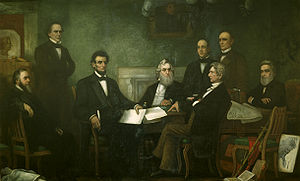 Lincoln presents the first draft of the Emancipation Proclamation to his cabinet. Painted by Francis Bicknell Carpenter in 1864
Lincoln presents the first draft of the Emancipation Proclamation to his cabinet. Painted by Francis Bicknell Carpenter in 1864
On June 19, 1862, Congress passed an act banning slavery on all federal territory, and in July 1862 passed the Second Confiscation Act, which set up court procedures that could free the slaves of anyone convicted of aiding the rebellion. Although Lincoln believed it was not within Congress's power to free the slaves within the states, he approved the bill in deference to the legislature. He felt such action could only be taken by the commander-in-chief using war powers granted to the president by the Constitution, and Lincoln was planning to take that action. In that month, Lincoln discussed a draft of the Emancipation Proclamation with his cabinet. In it, he stated that "as a fit and necessary military measure, on January 1, 1863, all persons held as slaves in the Confederate states will thenceforward, and forever, be free."[174]
Privately, Lincoln concluded at this point that the war could not be won without freeing the slaves. However Confederate and anti-war propagandists had success spreading the theme that emancipation was a stumbling block to peace and reunification. Republican editor Horace Greeley of the highly influential New York Tribune fell for the ploy.[175] and Lincoln refuted it directly in a shrewd letter of August 22, 1862. The President said the primary goal of his actions as president (he used the first person pronoun and explicitly refers to his "official duty") was preserving the Union:
My paramount object in this struggle is to save the Union, and is not either to save or to destroy slavery. If I could save the Union without freeing any slave I would do it, and if I could save it by freeing all the slaves I would do it; and if I could save it by freeing some and leaving others alone I would also do that. What I do about slavery, and the colored race, I do because I believe it helps to save the Union; and what I forbear, I forbear because I do not believe it would help to save the Union. . . . [¶] I have here stated my purpose according to my view of official duty; and I intend no modification of my oft-expressed personal wish that all men everywhere could be free.[176]Lincoln had over and over again made clear that he wanted the states to emancipate the slaves (which they officially did in 1865 by ratifying the Thirteenth Amendment). His role in leading the national army would be to save the union, using every tool available, including complete or partial emancipation (he employed partial emancipation). As for the Confederates, they would return only at the point of a bayonet.[177]
The Emancipation Proclamation, issued on September 22, 1862, and put into effect on January 1, 1863, declared free the slaves in ten states not then under Union control, with exemptions specified for areas already under Union control in two states.[178] Once the abolition of slavery in the rebel states became a military objective, as Union armies advanced south, more slaves were liberated until over three million of them in Confederate territory were freed. Lincoln's comment on the signing of the Proclamation was: "I never, in my life, felt more certain that I was doing right, than I do in signing this paper."[179] For some time, Lincoln continued earlier plans to set up colonies for the newly freed slaves. He commented favorably on colonization in the Emancipation Proclamation, but all attempts at such a massive undertaking failed.[180] A few days after Emancipation was announced, 13 Republican governors met at the War Governors' Conference; they supported the president's Proclamation, but suggested the removal of General George B. McClellan as commander of the Union Army.[181]
Using former slaves in the military was official government policy after the issuance of the Emancipation Proclamation. At first, Lincoln was reluctant to fully implement this program, but by the spring of 1863, he was ready to initiate "a massive recruitment of Negro troops". In a letter to Andrew Johnson, the military governor of Tennessee, encouraging him to lead the way in raising black troops, Lincoln wrote, "The bare sight of 50,000 armed and drilled black soldiers on the banks of the Mississippi would end the rebellion at once".[182] By the end of 1863, at Lincoln's direction, General Lorenzo Thomas had recruited 20 regiments of blacks from the Mississippi Valley.[183] Frederick Douglass once observed of Lincoln: "In his company, I was never reminded of my humble origin, or of my unpopular color".[184]
Gettysburg Address
Main article: Gettysburg AddressWith the great Union victory at the Battle of Gettysburg in July 1863, and the defeat of the Copperheads in the Ohio election in the fall, Lincoln maintained a strong base of party support and was in a strong position to redefine the war effort, despite the New York City draft riots. The stage was set for his address at the Gettysburg battlefield cemetery.[185] Defying Lincoln's prediction that "the world will little note, nor long remember what we say here," the Address became the most quoted speech in American history.[4]
The Gettysburg Address was delivered at the dedication of the Soldiers' National Cemetery in Gettysburg, Pennsylvania, on the afternoon of Thursday, November 19, 1863. In 272 words, and three minutes, Lincoln asserted the nation was born, not in 1789, but in 1776, "conceived in Liberty, and dedicated to the proposition that all men are created equal." He defined the war as an effort dedicated to these principles of liberty and equality for all. The emancipation of slaves was now part of the national war effort. He declared that the deaths of so many brave soldiers would not be in vain, that slavery would end as a result of the losses, and the future of democracy would be assured, that "government of the people, by the people, for the people, shall not perish from the earth." Lincoln concluded that the Civil War had a profound objective—a new birth of freedom in the nation.[186][187]
General Grant
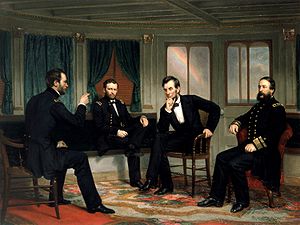 President Lincoln (center right) with, from left, Generals Sherman, Grant and Admiral Porter – 1868 painting of events aboard the River Queen in March, 1865
President Lincoln (center right) with, from left, Generals Sherman, Grant and Admiral Porter – 1868 painting of events aboard the River Queen in March, 1865
Meade's failure to capture Lee's army as it retreated from Gettysburg, and the continued passivity of the Army of the Potomac, persuaded Lincoln that a change in command was needed. General Ulysses S. Grant's victories at the Battle of Shiloh and in the Vicksburg campaign impressed Lincoln and made Grant a strong candidate to head the Union Army. Responding to criticism of Grant after Shiloh, Lincoln had said, "I can't spare this man. He fights."[188] With Grant in command, Lincoln felt the Union Army could relentlessly pursue a series of coordinated offensives in multiple theaters, and have a top commander who agreed on the use of black troops.[189]
Nevertheless, Lincoln was concerned that Grant might be considering a candidacy for President in 1864, as McClellan was. Lincoln arranged for an intermediary to make inquiry into Grant's political intentions, and being assured that he had none, submitted to the Senate Grant's promotion to commander of the Union Army. He obtained Congress's consent to reinstate for Grant the rank of Lieutenant General, which no officer had held since George Washington.[190]
Grant waged his bloody Overland Campaign in 1864. This is often characterized as a war of attrition, given high Union losses at battles such as the Battle of the Wilderness and Cold Harbor. Even though they had the advantage of fighting on the defensive, the Confederate forces had "almost as high a percentage of casualties as the Union forces".[191] The high casualty figures of the Union alarmed the North; Grant had lost a third of his army, and Lincoln asked what Grant's plans were, to which the general replied, "I propose to fight it out on this line if it takes all summer."[192]
The Confederacy lacked reinforcements, so Lee's army shrank with every battle, forcing it back to trenches outside Petersburg, Virginia, where Grant began a siege. Lincoln then made an extended visit to Grant's headquarters at City Point, Virginia. This allowed the president to confer in person with Grant and William Tecumseh Sherman about the hostilities, as Sherman coincidentally managed a hasty visit to Grant from his position in North Carolina.[193] Lincoln and the Republican party mobilized support for the draft throughout the North, and replaced his losses.[194]
Lincoln authorized Grant to target the Confederate infrastructure—such as plantations, railroads, and bridges—hoping to destroy the South's morale and weaken its economic ability to continue fighting. Grant's move to Petersburg resulted in the obstruction of three railroads between Richmond and the South. This strategy allowed Generals Sherman and Philip Sheridan to destroy plantations and towns in Virginia's Shenandoah Valley. The damage caused by Sherman's March to the Sea through Georgia in 1864 was limited to a 60-mile (97 km) swath but neither Lincoln nor his commanders saw destruction as the main goal, but rather defeat of the Confederate armies. As Neely (2004) concludes, there was no effort to engage in "total war" against civilians, as in World War II.[195]
Confederate general Jubal Anderson Early began a series of assaults in the North that threatened the Capital. During his raid on Washington, D.C. in 1864, Lincoln was watching the combat from an exposed position; Captain Oliver Wendell Holmes shouted at him, "Get down, you damn fool, before you get shot!"[196] After repeated calls on Grant to defend Washington, Sheridan was appointed and the threat from Early was dispatched.[197]
As Grant continued to wear down Lee's forces, efforts to discuss peace began. Confederate Vice President Stephens led a group to meet with Lincoln, Seward, and others at Hampton Roads. Lincoln refused to allow any negotiation with the Confederacy as a coequal; his sole objective was an agreement to end the fighting and the meetings produced no results.[198] On April 1, 1865, Grant successfully outflanked Lee's forces in the Battle of Five Forks and nearly encircled Petersburg, and the Confederate government evacuated Richmond. Days later, when that city fell, Lincoln visited the vanquished Confederate capital; as he walked through the city, white Southerners were stone-faced, but freedmen greeted him as a hero. On April 9, Lee surrendered to Grant at Appomattox and the war was effectively over.[199]
1864 re-election
Main articles: Electoral history of Abraham Lincoln and United States presidential election, 1864Lincoln was a master politician, bringing together—and holding together—all the main factions of the Republican Party, and bringing in War Democrats such as Edwin M. Stanton and Andrew Johnson as well. Lincoln spent many hours a week talking to politicians from across the land and using his patronage powers—greatly expanded over peacetime—to hold the factions of his party together, build support for his own policies, and fend off efforts by Radicals to drop him from the 1864 ticket.[200][201] At its 1864 convention, the Republican Party selected Andrew Johnson, a War Democrat from the Southern state of Tennessee, as his running mate. To broaden his coalition to include War Democrats as well as Republicans, Lincoln ran under the label of the new Union Party.[202]
When Grant's spring campaigns turned into bloody stalemates and Union casualties mounted, the lack of military success wore heavily on the President's re-election prospects, and many Republicans across the country feared that Lincoln would be defeated. Sharing this fear, Lincoln wrote and signed a pledge that, if he should lose the election, he would still defeat the Confederacy before turning over the White House:[203]
This morning, as for some days past, it seems exceedingly probable that this Administration will not be re-elected. Then it will be my duty to so co-operate with the President elect, as to save the Union between the election and the inauguration; as he will have secured his election on such ground that he cannot possibly save it afterward.[204]Lincoln did not show the pledge to his cabinet, but asked them to sign the sealed envelope.
An electoral landslide (in red) for Lincoln in the 1864 election, southern states (brown) and territories (light brown) not in playWhile the Democratic platform followed the Peace wing of the party and called the war a "failure", their candidate, General George B. McClellan, supported the war and repudiated the platform. Lincoln provided Grant with more troops and mobilized his party to renew its support of Grant in the war effort. Sherman's capture of Atlanta in September and David Farragut's capture of Mobile ended defeatist jitters;[205] the Democratic Party was deeply split, with some leaders and most soldiers openly for Lincoln. By contrast, the National Union Party was united and energized as Lincoln made emancipation the central issue, and state Republican parties stressed the perfidy of the Copperheads.[206] Lincoln was re-elected in a landslide, carrying all but three states, and receiving 78 percent of the Union soldiers' vote.[207]
On March 4, 1865, Lincoln delivered his second inaugural address. In it, he deemed the high casualties on both sides to be God's will. Historian Mark Noll concludes it ranks "among the small handful of semi-sacred texts by which Americans conceive their place in the world".[208] Lincoln said:
Fondly do we hope—fervently do we pray—that this mighty scourge of war may speedily pass away. Yet, if God wills that it continue, until all the wealth piled by the bond-man's 250 years of unrequited toil shall be sunk, and until every drop of blood drawn with the lash, shall be paid by another drawn with the sword, as was said 3,000 years ago, so still it must be said, "the judgments of the Lord, are true and righteous altogether". With malice toward none; with charity for all; with firmness in the right, as God gives us to see the right, let us strive on to finish the work we are in; to bind up the nation's wounds; to care for him who shall have borne the battle, and for his widow, and his orphan—to do all which may achieve and cherish a just and lasting peace, among ourselves, and with all nations.[209]Reconstruction
Main article: Reconstruction Era of the United StatesReconstruction began during the war, as Lincoln and his associates anticipated questions of how to reintegrate the conquered southern states, and how to determine the fates of Confederate leaders and freed slaves. Shortly after Lee's surrender, a general had asked Lincoln how the defeated Confederates should be treated, and Lincoln replied, "Let 'em up easy."[210] In keeping with that sentiment, Lincoln led the moderates regarding Reconstruction policy, and was opposed by the Radical Republicans, under Rep. Thaddeus Stevens, Sen. Charles Sumner and Sen. Benjamin Wade, political allies of the president on other issues. Determined to find a course that would reunite the nation and not alienate the South, Lincoln urged that speedy elections under generous terms be held throughout the war. His Amnesty Proclamation of December 8, 1863, offered pardons to those who had not held a Confederate civil office, had not mistreated Union prisoners, and would sign an oath of allegiance.[211]
As Southern states were subdued, critical decisions had to be made as to their leadership while their administrations were re-formed. Of special importance were Tennessee and Arkansas, where Lincoln appointed Generals Andrew Johnson and Frederick Steele as military governors, respectively. In Louisiana, Lincoln ordered General Nathaniel P. Banks to promote a plan that would restore statehood when 10 percent of the voters agreed to it. Lincoln's Democratic opponents seized on these appointments to accuse him of using the military to ensure his and the Republicans' political aspirations. On the other hand, the Radicals denounced his policy as too lenient, and passed their own plan, the Wade-Davis Bill, in 1864. When Lincoln vetoed the bill, the Radicals retaliated by refusing to seat representatives elected from Louisiana, Arkansas, and Tennessee.[212]
Lincoln's appointments were designed to keep both the moderate and Radical factions in harness. To fill Chief Justice Taney's seat on the Supreme Court, he named the choice of the Radicals, Salmon P. Chase, who Lincoln believed would uphold the emancipation and paper money policies.[213]
After implementing the Emancipation Proclamation, which did not apply to every state, Lincoln increased pressure on Congress to outlaw slavery throughout the entire nation with a constitutional amendment. Lincoln declared that such an amendment would "clinch the whole matter".[214] By December 1863 a proposed constitutional amendment that would outlaw slavery absolutely was brought to Congress for passage. This first attempt at an amendment failed to pass, falling short of the required two-thirds majority on June 15, 1864, in the House of Representatives. Passage of the proposed amendment became part of the Republican/Unionist platform in the election of 1864. After a long debate in the House, a second attempt passed Congress on January 13, 1865, and was sent to the state legislatures for ratification.[215] Upon ratification, it became the Thirteenth Amendment to the United States Constitution on December 6, 1865.[216]
As the war drew to a close, Lincoln's presidential Reconstruction for the South was in flux; having believed the federal government had limited responsibility to the millions of freedmen. He signed into law Senator Charles Sumner's Freedman's Bureau bill that set up a temporary federal agency designed to meet the immediate material needs of former slaves. The law assigned land for a lease of three years with the ability to purchase title for the freedmen. Lincoln stated that his Louisiana plan did not apply to all states under Reconstruction. Shortly before his assassination Lincoln announced he had a new plan for southern Reconstruction. Discussions with his cabinet revealed Lincoln planned short term military control over southern states, until readmission under the control of southern Unionists.[217]
Redefining the republic and republicanism
The successful reunification of the states had consequences for the name of the country. The term "the United States" has historically been used, sometimes in the plural ("these United States"), and other times in the singular, without any particular grammatical consistency. The Civil War was a significant force in the eventual dominance of the singular usage by the end of the nineteenth century.[218]
In recent years, historians[who?] have stressed Lincoln's redefinition of republican values. As early as the 1850s, a time when most political rhetoric focused on the sanctity of the Constitution, Lincoln redirected emphasis to the Declaration of Independence as the foundation of American political values—what he called the "sheet anchor" of republicanism.[219] The Declaration's emphasis on freedom and equality for all, in contrast to the Constitution's tolerance of slavery, shifted the debate. As Diggins concludes regarding the highly influential Cooper Union speech of early 1860, "Lincoln presented Americans a theory of history that offers a profound contribution to the theory and destiny of republicanism itself."[220] His position gained strength because he highlighted the moral basis of republicanism, rather than its legalisms.[221] Nevertheless, in 1861, Lincoln justified the war in terms of legalisms (the Constitution was a contract, and for one party to get out of a contract all the other parties had to agree), and then in terms of the national duty to guarantee a republican form of government in every state.[222]
In March 1861, in his First Inaugural Address, Lincoln explored the nature of democracy. He denounced secession as anarchy, and explained that majority rule had to be balanced by constitutional restraints in the American system. He said "A majority held in restraint by constitutional checks and limitations, and always changing easily with deliberate changes of popular opinions and sentiments, is the only true sovereign of a free people."[223]
Other enactments
Lincoln adhered to the Whig theory of the presidency, which gave Congress primary responsibility for writing the laws while the Executive enforced them. Lincoln only vetoed four bills passed by Congress; the only important one was the Wade-Davis Bill with its harsh program of Reconstruction.[224] He signed the Homestead Act in 1862, making millions of acres of government-held land in the West available for purchase at very low cost. The Morrill Land-Grant Colleges Act, also signed in 1862, provided government grants for agricultural colleges in each state. The Pacific Railway Acts of 1862 and 1864 granted federal support for the construction of the United States' First Transcontinental Railroad, which was completed in 1869.[225] The passage of the Homestead Act and the Pacific Railway Acts was made possible by the absence of Southern congressmen and senators who had opposed the measures in the 1850s.[226]
The Lincoln Cabinet[227] Office Name Term President Abraham Lincoln 1861–1865 Vice President Hannibal Hamlin 1861–1865 Andrew Johnson 1865 State William H. Seward 1861–1865 War Simon Cameron 1861–1862 Edwin M. Stanton 1862–1865 Treasury Salmon P. Chase 1861–1864 William P. Fessenden 1864–1865 Hugh McCulloch 1865 Justice Edward Bates 1861–1864 James Speed 1864–1865 Post Montgomery Blair 1861–1864 William Dennison, Jr. 1864–1865 Navy Gideon Welles 1861–1865 Interior Caleb B. Smith 1861–1862 John P. Usher 1863–1865 Other important legislation involved two measures to raise revenues for the Federal government: tariffs (a policy with long precedent), and a new Federal income tax. In 1861, Lincoln signed the second and third Morrill Tariff, the first having become law under James Buchanan. In 1861, Lincoln signed the Revenue Act of 1861, creating the first U.S. income tax.[228] This created a flat tax of 3 percent on incomes above $800, which was later changed by the Revenue Act of 1862 to a progressive rate structure.[229]
Lincoln also presided over the expansion of the federal government's economic influence in several other areas. The creation of the system of national banks by the National Banking Act provided a strong financial network in the country. It also established a national currency. In 1862, Congress created, with Lincoln's approval, the Department of Agriculture.[230] In 1862, Lincoln sent a senior general, John Pope, to put down the "Sioux Uprising" in Minnesota. Presented with 303 execution warrants for convicted Santee Dakota who were accused of killing innocent farmers, Lincoln conducted his own personal review of each of these warrants, eventually approving 39 for execution (one was later reprieved).[231] President Lincoln had planned to reform federal Indian policy.[232]
In the wake of Grant's casualties in his campaign against Lee, Lincoln had considered yet another executive call for a military draft, but it was never issued. In response to rumors of one, however, the editors of the New York World and the Journal of Commerce published a false draft proclamation which created an opportunity for the editors and others employed at the publications to corner the gold market. Lincoln's reaction was to send the strongest of messages to the media about such behavior; he ordered the military to seize the two papers. The seizure lasted for two days.[233]
Lincoln is largely responsible for the institution of the Thanksgiving holiday in the United States.[234] Before Lincoln's presidency, Thanksgiving, while a regional holiday in New England since the 17th century, had only been proclaimed by the federal government sporadically, and on irregular dates. The last such proclamation had been during James Madison's presidency 50 years before. In 1863, Lincoln declared the final Thursday in November of that year to be a day of Thanksgiving.[234] In June 1864, Lincoln approved the Yosemite Grant enacted by Congress, which provided unprecedented federal protection for the area now known as Yosemite National Park.[235]
Administration, cabinet and Supreme Court appointments 1861–1865
Lincoln's declared philosophy on court nominations was that "we cannot ask a man what he will do, and if we should, and he should answer us, we should despise him for it. Therefore we must take a man whose opinions are known."[234] Lincoln made five appointments to the United States Supreme Court. Noah Haynes Swayne, nominated January 21, 1862 and appointed January 24, 1862, was chosen as an anti-slavery lawyer who was committed to the Union. Samuel Freeman Miller, nominated and appointed on July 16, 1862, supported Lincoln in the 1860 election and was an avowed abolitionist. David Davis, Lincoln's campaign manager in 1860, nominated December 1, 1862 and appointed December 8, 1862, had also served as a judge in Lincoln's Illinois court circuit. Stephen Johnson Field, a previous California Supreme Court justice, was nominated March 6, 1863 and appointed March 10, 1863, and provided geographic balance, as well as political balance to the court as a Democrat. Finally, Lincoln's Treasury Secretary, Salmon P. Chase, was nominated as Chief Justice, and appointed the same day, on December 6, 1864. Lincoln believed Chase was an able jurist, would support Reconstruction legislation, and that his appointment united the Republican Party.[236]
States admitted to the Union
West Virginia, admitted to the Union June 20, 1863, contained the former north-westernmost counties of Virginia that seceded from Virginia after that commonwealth declared its secession from the Union. Nevada, which became the third State in the far-west of the continent, was admitted October 31, 1864. Lincoln recognized both of these state governments when formed locally, but was not otherwise involved prior to their admission by Congress.[237]
Assassination
Main articles: Assassination of Abraham Lincoln and Funeral and burial of Abraham LincolnJohn Wilkes Booth was a well-known actor and a Confederate spy from Maryland; though he never joined the Confederate army, he had contacts with the Confederate secret service.[238] In 1864, Booth formulated a plan (very similar to one of Thomas N. Conrad previously authorized by the Confederacy)[239] to kidnap Lincoln in exchange for the release of Confederate prisoners.
After attending an April 11, 1865, speech in which Lincoln promoted voting rights for blacks, an incensed Booth changed his plans and became determined to assassinate the president.[240] Learning that the President, First Lady, and head Union general Ulysses S. Grant would be attending Ford's Theatre, Booth formulated a plan with co-conspirators to assassinate Vice President Andrew Johnson, Secretary of State William H. Seward and General Grant. Without his main bodyguard, Ward Hill Lamon, Lincoln left to attend the play Our American Cousin on April 14. Grant along with his wife chose at the last minute to travel to Philadelphia instead of attending the play.[241]
Lincoln's bodyguard, John Parker, left Ford's Theater during intermission to join Lincoln's coachman for drinks in the Star Saloon next door. The now unguarded President sat in his state box in the balcony. Seizing the opportunity, Booth crept up from behind and at about 10:13 pm, aimed at the back of Lincoln's head and fired at point-blank range, mortally wounding the President. Major Henry Rathbone momentarily grappled with Booth but Booth stabbed him and escaped.[242][243]
After being on the run for ten days, Booth was tracked down and found on a farm in Virginia, some 30 miles (48 km) south of Washington D.C. After a brief fight, Booth was killed by Union soldiers on April 26.[244]
An Army surgeon, Doctor Charles Leale, assessed Lincoln's wound as mortal. The dying man was taken across the street to Petersen House. After being in a coma for nine hours, Lincoln died at 7:22 am on April 15. Presbyterian minister Phineas Densmore Gurley, then present, was asked to offer a prayer, after which Secretary of War Stanton saluted and said, "Now he belongs to the ages."[245]
Lincoln's flag-enfolded body was then escorted in the rain to the White House by bareheaded Union officers, while the city's church bells rang. Vice President Johnson was sworn in as President at 10:00 am the day after the assassination. Lincoln lay in state in the East Room, and then in the Capitol Rotunda from April 19 – April 21. For three weeks his funeral train brought the body to cities across the North for large-scale memorials attended by hundreds of thousands, as well as many people who gathered in informal trackside tributes with bands, bonfires and hymn singing.[246][247]
Religious and philosophical beliefs
Further information: Abraham Lincoln and religion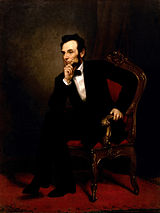 Lincoln: painting by George Peter Alexander Healy in 1869
Lincoln: painting by George Peter Alexander Healy in 1869
Scholars[who?] have extensively written on topics concerning Lincoln's beliefs and philosophy; e.g. whether Lincoln's frequent use of religious imagery and language reflected his own personal beliefs or was a device to appeal to his audiences, who were mostly evangelical Protestants.[248] Though he never joined a church, Lincoln was familiar with the Bible, quoted it and praised it.[249]
In the 1840s Lincoln subscribed to the Doctrine of Necessity, a belief that asserted the human mind was controlled by some higher power.[250] Some scholars[who?] maintain that in the 1850s, Lincoln acknowledged "providence" in a general way, and rarely used the language or imagery of the evangelicals; instead, they[who?] argue, he regarded the republicanism of the Founding Fathers with an almost religious reverence. Some historians[who?] also conclude that when he suffered the death of his son Edward, Lincoln more frequently acknowledged his own need to depend on God.[251]
As Lincoln grew older, it maybe the idea of a divine will somehow interacting with human affairs increasingly influenced his beliefs and public expressions. On a personal level, the death of his son Willie in February 1862 may have caused Lincoln to look towards religion for answers and solace.[252] After Willie's death, in the summer or early fall of 1862, Lincoln apparently attempted to put on paper his private thoughts on why, from a divine standpoint, the severity of the war was necessary. He wrote at this time that God "could have either saved or destroyed the Union without a human contest. Yet the contest began. And having begun He could give the final victory to either side any day. Yet the contest proceeds."[253] In April 1864, discussing Emancipation, Lincoln wrote, "I claim not to have controlled events, but confess plainly that events have controlled me. Now, at the end of three years struggle the nation's condition is not what either party, or any man devised, or expected. God alone can claim it."[254]
Historical reputation
In surveys of scholars ranking Presidents, Lincoln is ranked in the top three, often #1. A 2004 study found that scholars in the fields of history and politics ranked Lincoln number one, while legal scholars placed him second after Washington.[255]
President Lincoln's assassination made him a national martyr and endowed him with a recognition of mythic proportion. Lincoln was viewed by abolitionists as a champion for human liberty. Republicans linked Lincoln's name to their party. Many, though not all, in the South considered Lincoln as a man of outstanding ability.[256]
 The Abraham Lincoln Presidential Library and Museum focuses on Lincoln scholarship and popular interpretation
The Abraham Lincoln Presidential Library and Museum focuses on Lincoln scholarship and popular interpretation
Schwartz argues that Lincoln's reputation grew slowly in the late 19th century until the Progressive Era (1900-1920s) when he emerged as one of the most venerated heroes in American history, with even white Southerners in agreement. The high point came in 1922 with the dedication of the Lincoln Memorial on the Mall in Washington.[257] In the New Deal era liberals honored Lincoln not so much as the self-made man or the great war president, but as the advocate of the common man who doubtless would have supported the welfare state. In the Cold War years, Lincoln's image shifted to emphasize the symbol of freedom who brought hope to those oppressed by communist regimes.[258]
In recent decades[when?], Lincoln became a hero to political conservatives (apart from neo-Confederates)[clarification needed] for his intense nationalism, support for business, his insistence on stopping the spread of un-freedom (slavery), his acting in terms of Lockean and Burkean principles[clarification needed], and his devotion to the principles of the Founding Fathers.[259][260][261] As a Whig activist, Lincoln was a spokesman for business interests, favoring high tariffs, banks, internal improvements, and railroads in opposition to the agrarian Democrats.[262] William C. Harris found that Lincoln's "reverence for the Founding Fathers, the Constitution, the laws under it, and the preservation of the Republic and its institutions undergirded and strengthened his conservatism.".[263] James G. Randall emphasizes his tolerance and his especially his moderation "in his preference for orderly progress, his distrust of dangerous agitation, and his reluctance toward ill digested schemes of reform." Randall concludes that, "he was conservative in his complete avoidance of that type of so-called 'radicalism' which involved abuse of the South, hatred for the slaveholder, thirst for vengeance, partisan plotting, and ungenerous demands that Southern institutions be transformed overnight by outsiders."[264]
By the late 1960s liberals[who?] were having second thoughts, especially regarding Lincoln's views on racial issues.[265][266] Black historian Lerone Bennett won wide attention when he called Lincoln a white supremacist in 1968.[267] Critics[who?] complained that Lincoln used ethnic slurs, told jokes that ridiculed blacks, insisted he opposed social equality, and proposed sending freed slaves to another country. Defenders[who?] retorted that he was not as bad as most politicians;[268] and that he was a "moral visionary" who deftly advanced the abolitionist cause, as fast as politically possible.[269] The emphasis shifted away from Lincoln-the-emancipator to an argument that blacks had freed themselves from slavery, or at least were responsible for pressuring the government on emancipation.[270][271] Historian Barry Schwartz wrote in 2009 that Lincoln's image suffered "erosion, fading prestige, benign ridicule," in the late 20th century.[272] Whereas, Donald in his 1996 biography opined that Lincoln was distinctly endowed with the personality trait of negative capability, defined by the poet John Keats and attributed to extraordinary leaders who were "content in the midst of uncertainties and doubts, and not compelled toward fact or reason."[273]
Memorials
Further information: Cultural depictions of Abraham LincolnLincoln has been memorialized in many town, city, and county names,[274] including the capital of Nebraska. The first public monument to Abraham Lincoln was a statue erected in front of the District of Columbia City Hall in 1868, three years after his assassination.[275] Lincoln's name and image appear in numerous other places, such as the Lincoln Memorial in Washington, D.C. and Lincoln's sculpture on Mount Rushmore.[276] Abraham Lincoln Birthplace National Historical Park in Hodgenville, Kentucky,[277] Lincoln Boyhood National Memorial in Lincoln City, Indiana,[278] Lincoln's New Salem, Illinois,[279] and Lincoln Home National Historic Site in Springfield, Illinois[280] commemorate the president.[281] Ford's Theatre and Petersen House (where he died) are maintained as museums, as is the Abraham Lincoln Presidential Library and Museum, located in Springfield.[282][283] The Lincoln Tomb in Oak Ridge Cemetery in Springfield, Illinois, contains his remains and those of his wife Mary and three of his four sons, Edward, William, and Thomas.[284]
Within a year of this death, his image began to be disseminated throughout the world on stamps,[285] and he is the only U.S. President to appear on a U.S. airmail stamp.[286] Currency honoring the president includes the United States five-dollar bill and the Lincoln cent, which represents the first regularly circulating U.S. coin to feature an actual person.[287]
Abraham Lincoln's birthday, February 12, was never a national holiday, but it was at one time observed by as many as 30 states.[274] In 1971, Presidents Day became a national holiday, combining Lincoln's and Washington's birthdays and replacing most states' celebration of his birthday.[288] The Abraham Lincoln Association was formed in 1908 to commemorate the centennial of Lincoln's birth.[289] In 2000, Congress established the Abraham Lincoln Bicentennial Commission to commemorate his 200th birthday in February 2009.[290]
Lincoln sites remain popular tourist attractions, but crowds have thinned. In the late 1960s, 650,000 people a year visited the home in Springfield, slipping to 393,000 in 2000–2003. Likewise visits to New Salem fell by half, probably because of the enormous draw of the new museum in Springfield. Visits to the Lincoln Memorial in Washington peaked at 4.3 million in 1987 and have since declined. However crowds at Ford's Theatre in Washington have grown sharply.[291]
References
- ^ Goodwin, p. 91; Holzer, p. 232.
- ^ Tagg, p. xiii.
- ^ Randall (1947), pp. 65–87.
- ^ a b Bulla (2010), p. 222.
- ^ Donald (1996), pp. 20–22.
- ^ a b Pessen, pp. 24–25.
- ^ a b White, pp. 12–13.
- ^ Donald (1996), p. 21.
- ^ Donald (1996), pp. 22–24.
- ^ Lamb, p. 189.
- ^ a b Sandburg (1926), p. 20.
- ^ a b Donald (1996), pp. 30–33.
- ^ Donald (1996), p. 20.
- ^ Donald (1996), pp. 26–27.
- ^ White, pp. 25, 31, 47.
- ^ Donald (1996), p. 33.
- ^ Donald (1996), p. 41.
- ^ Donald (1996), pp. 28, 152.
- ^ Donald (1996), pp. 38–43; Prokopowicz, pp. 18–19.
- ^ Donald (1996), p. 36.
- ^ Thomas (2008), pp. 23–53; Carwardine (2003), pp. 3–5.
- ^ Sandburg (1926), pp. 22–23.
- ^ Donald (1996), pp. 55–58.
- ^ Donald (1996), pp. 67–69; Thomas (2008), pp. 56–57, 69–70.
- ^ Lamb, p. 43.
- ^ a b Sandburg (1926), pp. 46–48.
- ^ Donald (1996), p. 86.
- ^ Donald (1996), p. 87.
- ^ Sandburg (1926), pp. 50–51.
- ^ Donald (1996), p. 93.
- ^ White, p. 125.
- ^ Donald (1996), pp. 95–96.
- ^ White, p. 126.
- ^ Baker, p. 120.
- ^ White, pp. 179–181, 476.
- ^ Steers, p. 341.
- ^ Shenk, Joshua Wolf (October 2005). "Lincoln's Great Depression". The Atlantic. The Atlantic Monthly Group. Archived from the original on October 20, 2011. http://www.webcitation.org/62a4fProj.
- ^ Foner (1995), pp. 440–447.
- ^ Winkle ch 7–8.[page needed]
- ^ Winkle, pp. 86–95.
- ^ laughtergenealogy.com – Presidents Personal Information[unreliable source?]
- ^ Donald (1996), p. 46.
- ^ Winkle, pp. 114–116.
- ^ Donald (1996), pp. 53–55.
- ^ White, p. 59.
- ^ Donald (1996), p. 64.
- ^ White, pp. 71, 79, 108.
- ^ Donald (1948), p. 17.
- ^ Simon, p. 283.
- ^ Simon, p. 130.
- ^ Donald (1996), p. 134.
- ^ Foner (2010), pp. 17–19, 67.
- ^ Donald (1996), p. 222.
- ^ Boritt (1994), pp. 137–153.
- ^ Oates, p. 79.
- ^ Harris, p. 54; Foner (2010), p. 57.
- ^ Heidler (2006), pp. 181–183.
- ^ Holzer, p. 63.
- ^ Oates, pp. 79–80.
- ^ a b Basler (1946), pp. 199–202.
- ^ McGovern, p. 33.
- ^ Basler (1946), p. 202.
- ^ "Lincoln's Spot Resolutions". National Archives. Archived from the original on October 20, 2011. http://www.webcitation.org/62a5gtE9P.
- ^ Donald (1996), p. 128.
- ^ Donald (1996), pp. 124–126.
- ^ Donald (1996), p. 140.
- ^ Harris, pp. 55–57.
- ^ Donald (1996), p. 96.
- ^ Donald (1996), pp. 105–106, 158.
- ^ Donald (1996), pp. 142–143.
- ^ Donald (1996), pp. 156–157.
- ^ White, p. 163.
- ^ "Abraham Lincoln's Patent Model: Improvement for Buoying Vessels Over Shoals". Smithsonian Institution. Archived from the original on October 20, 2011. http://www.webcitation.org/62a7AMeAa.
- ^ a b Donald (1996), p. 155.
- ^ Dirck (2007), p. 92.
- ^ Handy, p. 440.
- ^ Donald (1996), pp. 155–156, 196–197.
- ^ a b c Donald (1996), pp. 150–151.
- ^ Harrison (1935), p. 270.
- ^ "The Peculiar Instution". Newberry Library and Chicago History Museum. Archived from the original on October 22, 2011. http://www.webcitation.org/62dB0ccYV.
- ^ "Lincoln Speaks Out". Newberry Library and Chicago History Museum. Archived from the original on October 22, 2011. http://www.webcitation.org/62dBlWFGi.
- ^ McGovern, pp. 36–37.
- ^ Foner (2010), pp. 84–88.
- ^ Thomas (2008), pp. 148–152.
- ^ White, p. 199.
- ^ Basler (1953), p. 255.[Full citation needed]
- ^ Oates, p. 119.
- ^ White, pp. 205–208.
- ^ McGovern, pp. 38–39.
- ^ Donald (1996), p. 193.
- ^ Oates, pp. 138–139.
- ^ Zarefsky, pp. 69–110.
- ^ Jaffa, pp. 299–300.
- ^ White, p. 251.
- ^ Harris, p. 98.
- ^ Donald (1996), p. 209.
- ^ McPherson (1993), p. 182.
- ^ Donald (1996), pp. 214–224.
- ^ Donald (1996), p. 223.
- ^ Carwardine (2003), pp. 89–90.
- ^ Donald (1996), pp. 242, 412.
- ^ Jaffa, p. 473.
- ^ Holzer, pp. 108–111.
- ^ Carwardine (2003), p. 97.
- ^ Holzer, p. 157.
- ^ Donald (1996), p. 240.
- ^ Donald (1996), p. 241.
- ^ Donald (1996), p. 244.
- ^ Oates, pp. 175–176.
- ^ Donald (1996), p. 245.
- ^ Luthin, pp. 609–629.
- ^ Hofstadter, pp. 50–55.
- ^ Donald (1996), pp. 247–250.
- ^ Boritt (1994), pp. 10, 13, 18.
- ^ Donald (1996), p. 253.
- ^ Donald (1996), pp. 254–256.
- ^ Donald (1996), p. 254.
- ^ Mansch, p. 61.
- ^ Harris, p. 243.
- ^ White, p. 350.
- ^ Nevins (1950), p. 312.[volume & issue needed]
- ^ Edgar, p. 350.
- ^ a b Donald (1996), p. 267.
- ^ Potter, p. 498.
- ^ White, p. 362.
- ^ Potter, pp. 520, 569–570.
- ^ White, p. 369.
- ^ White, pp. 360–361.
- ^ Donald (1996), p. 268.
- ^ Vorenberg, p. 22.
- ^ Lupton, p. 34.
- ^ Donald (1996), pp. 273–277.
- ^ Donald (1996), pp. 277–279.
- ^ Sandburg (2002), p. 212.
- ^ Donald (1996), pp. 283–284.
- ^ Donald (1996), pp. 268, 279.
- ^ Nevins (2000), p. 29.[Full citation needed]
- ^ Sherman, pp. 185–186.
- ^ Donald (1996), p. 293.
- ^ Oates, p. 226.
- ^ Heidler (2000), p. 174.
- ^ Scott, pp. 326–341.
- ^ Donald (1996), pp. 303–304; Carwardine (2003), pp. 163–164.
- ^ Donald (1996), pp. 315, 331–333, 338–339, 417.
- ^ Donald (1996), p. 314; Carwardine (2003), p. 178.
- ^ Donald (1996), pp. 314–317.
- ^ Carwardine (2003), p. 181.
- ^ Adams, pp. 540–562.
- ^ Donald (1996), p. 322.
- ^ Prokopowicz, p. 127.
- ^ Benjamin P. Thomas and Harold M. Hyman, Stanton, the Life and Times of Lincoln's Secretary of War (Knopf, 1962)[page needed]
- ^ Donald (1996), pp. 295–296.
- ^ Donald (1996), pp. 391–392.
- ^ Ambrose, pp. 7, 66, 159.
- ^ Donald (1996), pp. 432–436.
- ^ Donald (1996), pp. 318–319.
- ^ Donald (1996), pp. 349–352.
- ^ Donald (1996), pp. 360–361.
- ^ Nevins (1960), pp. 2:159–162.
- ^ Donald (1996), pp. 339–340.
- ^ Goodwin, pp. 478–479.
- ^ Goodwin, pp. 478–480.
- ^ Goodwin, p. 481.
- ^ Donald (1996), pp. 389–390.
- ^ Donald (1996), pp. 429–431.
- ^ Nevins (1960), pp. 343–367.[volume & issue needed]
- ^ Nevins (1960), pp. 318–322, quote on p. 322.[volume & issue needed]
- ^ Donald (1996), pp. 422–423.
- ^ Nevins (1960), pp. 2:432–450.
- ^ Donald (1996), pp. 444–447.
- ^ Donald (1996), p. 446.
- ^ Mackubin, Thomas Owens (March 25, 2004). "The Liberator". National Review. National Review. Archived from the original on October 20, 2011. http://www.webcitation.org/62a7fJ9hj.
- ^ Guelzo (1999), pp. 290–291.
- ^ Donald (1996), pp. 364–365.
- ^ McPherson (1992), p. 124.
- ^ Donald (1996), p. 368.
- ^ Guelzo (2004), pp. 147–153.
- ^ Donald (1996), pp. 364, 379.
- ^ Donald (1996), p. 407.
- ^ Donald (1996), p. 408.
- ^ Nevins (1960), pp. 2:239–240.
- ^ Donald (1996), pp. 430–431.
- ^ Donald (1996), p. 431.
- ^ Douglass, pp. 259–260.
- ^ Donald (1996), pp. 453–460.
- ^ Donald (1996), pp. 460–466.
- ^ Wills, pp. 20, 27, 105, 146.
- ^ Thomas (2008), p. 315.
- ^ Nevins (2000), (Vol. IV), pp. 6–17.[Full citation needed]
- ^ Donald (1996), pp. 490–492.
- ^ McPherson (2009), p. 113.
- ^ Donald (1996), p. 501.
- ^ "The Peacemakers". The White House Historical Association. Archived from the original on October 20, 2011. http://www.webcitation.org/62a8J9jOa.
- ^ Thomas (2008), pp. 422–424.
- ^ Neely (2004), pp. 434–458.
- ^ Thomas (2008), p. 434.
- ^ Donald (1996), pp. 516–518.
- ^ Donald (1996), p. 565.
- ^ Donald (1996), p. 589.
- ^ Fish, pp. 53–69.
- ^ Tegeder, pp. 77–90.
- ^ Donald (1996), pp. 494–507.
- ^ Grimsley, p. 80.
- ^ Basler (1953), p. 514.[Full citation needed]
- ^ Donald (1996), p. 531.
- ^ Randall & Current (1955), p. 307.
- ^ Paludan, pp. 274–293.
- ^ Noll, p. 426.
- ^ Basler (1953), p. 333.[Full citation needed]
- ^ Thomas (2008), pp. 509–512.
- ^ Donald (1996), pp. 471–472.
- ^ Donald (1996), pp. 485–486.
- ^ Nevins (2000), Vol IV., p. 206.[Full citation needed]
- ^ Donald (1996), p. 561.
- ^ Donald (1996), pp. 562–563.
- ^ "Primary Documents in American History: 13th Amendment to the U.S. Constitution". Library of Congress. Archived from the original on October 20, 2011. http://www.webcitation.org/62a9BIwNw.
- ^ Carwardine (2003), pp. 242–243.
- ^ "Presidential Proclamation-Civil War Sesquicentennial". The White House. April 12, 2011. Archived from the original on October 20, 2011. http://www.webcitation.org/62aAPoA6B. "...a new meaning was conferred on our country's name..."
- ^ Jaffa, p. 399.
- ^ Diggins, p. 307.
- ^ Foner (2010), p. 215.
- ^ Jaffa, p. 263.
- ^ Belz (1998), p. 86.
- ^ Donald (2001), p. 137.
- ^ Paludan, p. 116.
- ^ McPherson (1993), pp. 450–452.
- ^ Summers, Robert. "Abraham Lincoln". Internet Public Library 2 (IPL2). U. Michigan and Drexel U.. Archived from the original on October 22, 2011. http://www.webcitation.org/62dM1T7zn.
- ^ Donald (1996), p. 424.
- ^ Paludan, p. 111.
- ^ Donald (2001), p. 424.
- ^ Cox, p. 182.
- ^ Nichols, pp. 210–232.
- ^ Donald (1996), pp. 501–502.
- ^ a b c Donald (1996), p. 471.
- ^ Schaffer, p. 48.[Full citation needed]
- ^ Blue, p. 245.
- ^ Donald (1996), pp. 300, 539.
- ^ Donald (1996), pp. 586–587.
- ^ Donald (1996), p. 587.
- ^ Harrison (2000), pp. 3–4.
- ^ Donald (1996), pp. 594–597.
- ^ Donald (1996), p. 597.
- ^ Martin, Paul (April 8, 2010). "Lincoln's Missing Bodyguard". Smithsonian Magazine. Smithsonian Institution. Archived from the original on October 20, 2011. http://www.webcitation.org/62aAqLOzq.
- ^ Donald (1996), p. 599.
- ^ Donald (1996), pp. 598–599, 686. Witnesses have provided other versions of the quote, i.e. "He now belongs to the ages." and "He is a man for the ages."
- ^ Trostel, pp. 31–58.
- ^ Goodrich, pp. 231–238.
- ^ Carwardine (1997), pp. 27–55.
- ^ Donald (1996), pp. 48–49, 514–515.
- ^ Donald (1996), pp. 48–49.
- ^ Parrillo, pp. 227–253.
- ^ Wilson, pp. 251–254.
- ^ Wilson, p. 254.
- ^ Donald (1996), p. 514.
- ^ Taranto, p. 264.
- ^ Chesebrough, pp. 76, 79, 106, 110.
- ^ Schwartz (2000), p. 109.
- ^ Schwartz (2009), pp. 23, 91–98.
- ^ Belz (2006), pp. 514–518.
- ^ Graebner, pp. 67–94.
- ^ Smith, pp. 43–45.
- ^ Boritt (1994), pp. 196, 198, 228, 301.
- ^ Harris, p. 2.
- ^ Randall (1947), p. 175.
- ^ Zilversmit, pp. 22–24.
- ^ Smith, p. 42.
- ^ Bennett, pp. 35–42.
- ^ Dirck (2008), p. 31.
- ^ Striner, pp. 2–4.
- ^ Cashin, p. 61.
- ^ Kelley & Lewis, p. 228.
- ^ Schwartz (2009), p. 146.
- ^ Donald (1996), p. 15.
- ^ a b Dennis, p. 194.
- ^ "Renovation and Expansion of the Historic DC Courthouse" (PDF). DC Court of Appeals. Archived from the original on October 23, 2011. http://www.webcitation.org/62dfFdX74.
- ^ "Mount Rushmore National Memorial". U.S. National Park Service. Archived from the original on October 23, 2011. http://www.webcitation.org/62dfUtolh.
- ^ "Abraham Lincoln Birthplace National Historic Site". U.S. National Park Service. Archived from the original on October 23, 2011. http://www.webcitation.org/62dfhlRLE.
- ^ "Lincoln Boyhood National Memorial". U.S. National Park Service. Archived from the original on October 24, 2011. http://www.webcitation.org/62fLOWRqX.
- ^ "Lincoln's New Salem". Illinois Historic Preservation Agency. Archived from the original on October 24, 2011. http://www.webcitation.org/62fLY6Gyu.
- ^ "Lincoln Home National Historic Site". U.S. National Park Service. Archived from the original on October 24, 2011. http://www.webcitation.org/62fLhitWd.
- ^ Peterson, pp. 312, 368.
- ^ "The Abraham Lincoln Presidential Library and Museum". Abraham Lincoln Presidential Library and Museum. Archived from the original on October 25, 2011. http://www.webcitation.org/62i1pRLLD.
- ^ "About Ford's". Ford's Theatre. Archived from the original on October 25, 2011. http://www.webcitation.org/62i1ux7Sk.
- ^ "Lincoln Tomb". Illinois Historic Preservation Agency. Archived from the original on October 25, 2011. http://www.webcitation.org/62i23WFGo.
- ^ Healey, Matthew. "Lincoln Stamps Bring Neary $2 Million at a New York Auction". New York Times. Archived from the original on October 26, 2011. http://www.webcitation.org/62jmWGFib.
- ^ Cummings, p. 284.
- ^ Vinciguerra, Thomas (February 7, 2009). "Now if Only We Could Mint Lincoln Himself". The New York Times: p. WK4. Archived from the original on October 26, 2011. http://www.webcitation.org/62jmhWehf.
- ^ Schwartz (2009), pp. 196–199.
- ^ Peterson pp. 147, 263.
- ^ Carroll, James R. (January 12, 2009). "Let the Lincoln Bicentennial Celebrations Begin". The Courier-Journal. Archived from the original on October 26, 2011. http://www.webcitation.org/62jn5TYV5.
- ^ Schwartz (2009), pp. 153–155.
Bibliography
Main article: Bibliography of Abraham LincolnCited in footnotes
- Adams, Charles F. (April 1912). "The Trent Affair". The American Historical Review (The University of Chicago Press) 17 (3): 540–562. JSTOR 1834388.
- Ambrose, Stephen E. (1962). Halleck: Lincoln's Chief of Staff. Louisiana State University Press. OCLC 1178496.
- Baker, Jean H. (1989). Mary Todd Lincoln: A Biography. W. W. Norton & Company. ISBN 9780393305869.
- Basler, Roy Prentice, ed (1946). Abraham Lincoln: His Speeches and Writings. World Publishing. OCLC 518824.
- Belz, Herman (1998). Abraham Lincoln, Constitutionalism, and Equal Rights in the Civil War Era. Fordham University Press. ISBN 9780823217694.
- Belz, Herman (2006). "Lincoln, Abraham". In Frohnen, Bruce; Beer, Jeremy; Nelson, Jeffrey O.. American Conservatism: An Encyclopedia. ISI Books. ISBN 9781932236439.
- Bennett Jr, Lerone (February 1968). "Was Abe Lincoln a White Supremacist?". Ebony (Johnson Publishing) 23 (4). ISSN 0012-9011. http://books.google.com/books?id=H84DAAAAMBAJ&pg=PA35&source=gbs_toc_r&cad=2#v=onepage&q&f=false.
- Blue, Frederick J. (1987). Salmon P. Chase: a life in politics. The Kent State University Press. ISBN 0873383400.
- Boritt, Gabor (1994) [1978]. Lincoln and the Economics of the American Dream. University of Illinois Press. ISBN 0252064453.
- Bulla, David W.; Gregory A. Borchard (2010). Journalism in the Civil War Era. Peter Lang Publishing Inc.. ISBN 1433107228.
- Carwardine, Richard J. (Winter 1997). "Lincoln, Evangelical Religion, and American Political Culture in the Era of the Civil War". Journal of the Abraham Lincoln Association (Abraham Lincoln Association) 18 (1): 27–55. http://www.historycooperative.org/journals/jala/18.1/carwardine.html.
- Carwardine, Richard (2003). Lincoln. Pearson Education Ltd. ISBN 9780582032798.
- Cashin, Joan E. (2002). The War Was You and Me: Civilians in The American Civil War. Princeton University Press. ISBN 9780691091730.
- Chesebrough, David B. (1994). No Sorrow Like Our Sorrow. Kent State University Press. ISBN 9780873384919.
- Cox, Hank H. (2005). Lincoln And The Sioux Uprising of 1862. Cumberland House Publisher. ISBN 9781581824575.
- Cummings, William W.; James B. Hatcher (1982). Scott Specialized Catalogue of United States Stamps. Scott Publishing Company. ISBN 0894870424.
- Dennis, Matthew (2002). Red, White, and Blue Letter Days: an American Calendar. Cornell University Press. ISBN 9780801472688.
- Diggins, John P. (1986). The Lost Soul of American Politics: Virtue, Self-Interest, and the Foundations of Liberalism. University of Chicago Press. ISBN 0226148777.
- Dirck, Brian R. (2007). Lincoln Emancipated: The President and the Politics of Race. Northern Illinois University Press. ISBN 9780875803593.
- Dirck, Brian (2008). Lincoln the Lawyer. University of Illinois Press. ISBN 9780252076145.
- Donald, David Herbert (1948). Lincoln's Herndon. A. A. Knopf. OCLC 186314258.
- Donald, David Herbert (1996) [1995]. Lincoln. Simon and Schuster. ISBN 9780684825359.
- Donald, David Herbert (2001). Lincoln Reconsidered. Knopf Doubleday Publishing Group. ISBN 9780375725326.
- Douglass, Frederick (2008). The Life and Times of Frederick Douglass. Cosimo Classics. ISBN 1605203998.
- Edgar, Walter B. (1998). South Carolina: A History. University of South Carolina Press. ISBN 9781570032554.
- Fish, Carl Russell (October 1902). "Lincoln and the Patronage". American Historical Review (American Historical Association) 8 (1): 53–69. JSTOR 1832574.
- Foner, Eric (1995) [1970]. Free Soil, Free Labor, Free Men: The Ideology of the Republican Party before the Civil War. Oxford University Press. ISBN 9780195094978.
- Foner, Eric (2010). The Fiery Trial: Abraham Lincoln and American Slavery. W.W. Norton. ISBN 9780393066180.
- Goodwin, Doris Kearns (2005). Team of Rivals: The Political Genius of Abraham Lincoln. Simon & Schuster. ISBN 0684824906.
- Goodrich, Thomas (2005). The Darkest Dawn: Lincoln, Booth, and the Great American Tragedy. Indiana University Press. ISBN 9780253345677.
- Graebner, Norman (1959). "Abraham Lincoln: Conservative Statesman". The Enduring Lincoln: Lincoln Sesquicentennial Lectures at the University of Illinois. University of Illinois Press. OCLC 428674.
- Grimsley, Mark (2001). The Collapse of the Confederacy. University of Nebraska Press. ISBN 0803221703.
- Guelzo, Allen C. (1999). Abraham Lincoln: Redeemer President. W.B. Eerdmans Publishing. ISBN 0802838723.
- Guelzo, Allen C. (2004). Lincoln's Emancipation Proclamation: The End of Slavery in America. Simon & Schuster. ISBN 9780743221825.
- Handy, James S. (1917). Book Review: Abraham Lincoln, the Lawyer-Statesman. Northwestern University Law Publication Association.
- Harrison, J. Houston (1935). Settlers by the Long Grey Trail. J.K. Reubush. OCLC 3512772.
- Harrison, Lowell Hayes (2000). Lincoln of Kentucky. University Press of Kentucky. ISBN 0813121566.
- Harris, William C. (2007). Lincoln's Rise to the Presidency. University Press of Kansas. ISBN 9780700615209.
- Heidler, David S.; Jeanne T. Heidler, ed (2000). Encyclopedia of the American Civil War: A Political, Social, and Military History. W. W. Norton & Company, Inc. ISBN 9780393047585.
- Heidler, David Stephen (2006). The Mexican War. Greenwood Publishing Group. ISBN 9780313327926.
- Hofstadter, Richard (October 1938). "The Tariff Issue on the Eve of the Civil War". American Historical Review (American Historical Association) 44 (1): 50–55. JSTOR 1840850.
- Holzer, Harold (2004). Lincoln at Cooper Union: The Speech That Made Abraham Lincoln President. Simon & Schuster. ISBN 9780743299640.
- Jaffa, Harry V. (2000). A New Birth of Freedom: Abraham Lincoln and the Coming of the Civil War. Rowman & Littlefield. ISBN 0847699528.
- Lamb, Brian; Susan Swain, ed (2008). Abraham Lincoln: Great American Historians on Our Sixteenth President. PublicAffairs. ISBN 9781586486761.
- Kelley, Robin D. G.; Lewis, Earl (2005). To Make Our World Anew: Volume I: A History of African Americans to 1880. Oxford University Press. ISBN 9780198040064.
- Lupton, John A. (September–October 2006). "Abraham Lincoln and the Corwin Amendment". Illinois Heritage (The Illinois State Historical Society) 9 (5): 34. http://www.lib.niu.edu/2006/ih060934.html.
- Luthin, Reinhard H. (July 1994). "Abraham Lincoln and the Tariff". American Historical Review (American Historical Association) 49 (4): 609–629. JSTOR 1850218.
- Mansch, Larry D. (2005). Abraham Lincoln, President-Elect: The Four Critical Months from Election to Inauguration. McFarland. ISBN 078642026X.
- McGovern, George S. (2008). Abraham Lincoln. Macmillan. ISBN 9780805083453.
- McPherson, James M. (1992). Abraham Lincoln and the Second American Revolution. Oxford University Press. ISBN 9780195076066.
- McPherson, James M. (1993). Battle Cry of Freedom: the Civil War Era. Oxford University Press. ISBN 9780195168952.
- McPherson, James M. (2009). Abraham Lincoln. Oxford University Press. ISBN 9780195374520.
- Neely Jr., Mark E. (December 2004). "Was the Civil War a Total War?". Civil War History (The Kent State University Press) 50 (4): 434–458. http://muse.jhu.edu/login?uri=/journals/civil_war_history/v050/50.4neely.html.
- Nevins, Allan (1947). Ordeal of the Union; 2 vol. Scribner's. ISBN 9780684104164.
- Nevins, Allan (1950). The Emergence of Lincoln: Prologue to Civil War, 1857–1861 2 vol. Scribner's. ISBN 9780684104164., also published as vol 3–4 of Ordeal of the Union
- Nevins, Allan (1960–1971). The War for the Union; 4 vol 1861–1865. Scribner's. ISBN 9781568522975.; also published as vol 5–8 of Ordeal of the Union
- Nichols, David A. (2010). Richard W. Etulain. ed. Lincoln Looks West: From the Mississippi to the Pacific. Southern Illinois University. ISBN 0809329611.
- Noll, Mark (2000). America's God: From Jonathan Edwards to Abraham Lincoln. Oxford University Press. ISBN 0195151119.
- Oates, Stephen B. (1993). With Malice Toward None: a Life of Abraham Lincoln. HarperCollins. ISBN 9780060924713.
- Paludan, Phillip Shaw (1994). The Presidency of Abraham Lincoln. University Press of Kansas. ISBN 9780700606719.
- Parrillo, Nicholas (September 2000). "Lincoln's Calvinist Transformation: Emancipation and War". Civil War History (Kent State University Press) 46 (3): 227–253.
- Pessen, Edward (1984). The Log Cabin Myth: The Social Backgrounds of American Presidents. Yale University Press. ISBN 0300031661.
- Peterson, Merrill D. (1995). Lincoln in American Memory. Oxford University Press. ISBN 9780195096453.
- Potter, David M.; Don Edward Fehrenbacher (1976). The impending crisis, 1848–1861. HarperCollins. ISBN 9780061319297.
- Prokopowicz, Gerald J. (2008). Did Lincoln Own Slaves?. Vintage Books. ISBN 9780307279293.
- Randall, James G. (1947). Lincoln, the Liberal Statesman. Dodd, Mead. OCLC 748479.
- Randall, J.G.; Current, Richard Nelson (1955). Last Full Measure. Lincoln the President. IV. Dodd, Mead. OCLC 5852442.
- Sandburg, Carl. (1926). Abraham Lincoln: The Prairie Years. Harcourt, Brace & Company. OCLC 6579822.
- Sandburg, Carl (2002). Abraham Lincoln: The Prairie Years and the War Years. Houghton Mifflin Harcourt. ISBN 0156027526.
- Schwartz, Barry (2000). Abraham Lincoln and the Forge of National Memory. University Of Chicago Press. ISBN 978-0226741970.
- Schwartz, Barry (2009). Abraham Lincoln in the Post-Heroic Era: History and Memory in Late Twentieth-Century America. University of Chicago Press. ISBN 9780226741888.
- Scott, Kenneth (September 1948). "Press Opposition to Lincoln in New Hampshire". The New England Quarterly (The New England Quarterly, Inc.) 21 (3): 326–341. JSTOR 361094.
- Sherman, William T. (1990). Memoirs of General W.T. Sherman. BiblioBazaar. ISBN 1174631724.
- Simon, Paul (1990). Lincoln's Preparation for Greatness: The Illinois Legislative Years. University of Illinois. ISBN 0252002032.
- Smith, Robert C. (2010). Conservatism and Racism, and Why in America They Are the Same. State University of New York Press. ISBN 9781438432335.
- Steers, Edward (2010). The Lincoln Assassination Encyclopedia. Harper Collins. ISBN 0061787752.
- Striner, Richard (2006). Father Abraham: Lincoln's Relentless Struggle to End Slavery. Oxford University Press. ISBN 978-0195183061.
- Tagg, Larry (2009). The Unpopular Mr. Lincoln:The Story of America's Most Reviled President. Savas Beatie. ISBN 9781932714616.
- Taranto, James; Leonard Leo (2004). Presidential Leadership: Rating the Best and the Worst in the White House. Simon and Schuster. ISBN 9780743254335.
- Tegeder, Vincent G. (June 1948). "Lincoln and the Territorial Patronage: The Ascendancy of the Radicals in the West". Mississippi Valley Historical Review (Organization of American Historians) 35 (1): 77–90. JSTOR 1895140.
- Thomas, Benjamin P. (2008). Abraham Lincoln: A Biography. Southern Illinois University. ISBN 9780809328871.
- Trostel, Scott D. (2002). The Lincoln Funeral Train: The Final Journey and National Funeral for Abraham Lincoln. Cam-Tech Publishing. ISBN 9780925436214.
- Vorenberg, Michael (2001). Final Freedom: the Civil War, the Abolition of Slavery, and the Thirteenth Amendment. Cambridge University Press. ISBN 9780521652674.
- White, Jr., Ronald C. (2009). A. Lincoln: A Biography. Random House, Inc. ISBN 9781400064991.
- Wills, Garry (1993). Lincoln at Gettysburg: The Words That Remade America. Simon & Schuster. ISBN 0671867423.
- Wilson, Douglas L. (1999). Honor's Voice: The Transformation of Abraham Lincoln. Knopf Publishing Group. ISBN 9780375703966.
- Winkle, Kenneth J. (2001). The Young Eagle: The Rise of Abraham Lincoln. Taylor Trade Publications. ISBN 9780878332557.
- Zarefsky, David S. (1993). Lincoln, Douglas, and Slavery: In the Crucible of Public Debate. University of Chicago Press. ISBN 9780226978765.
- Zilversmit, Arthur (1980). "Lincoln and the Problem of Race: A Decade of Interpretations". Journal of the Abraham Lincoln Association (Abraham Lincoln Association) 2 (11): 22–24. http://www.historycooperative.org/journals/jala/2/zilversmit.html.
Additional references
- Burkhimer, Michael (2003). One Hundred Essential Lincoln Books. Cumberland House. ISBN 9781581823691.
- Burlingame, Michael (2008). Abraham Lincoln: A Life (2 volumes). Johns Hopkins University Press. ISBN 9780801889936.
- Cox, LaWanda (1981). Lincoln and Black Freedom: A Study in Presidential Leadership. University of South Carolina Press. ISBN 9780872494008.
- Foner, Eric (2008). Our Lincoln: New Perspectives on Lincoln and His World. W.W. Norton. ISBN 9780393067569.
- McPherson, James M. (2008). Tried by War: Abraham Lincoln as Commander in Chief. Penguin Press. ISBN 9781594201912.
- Neely, Mark E (1984). The Abraham Lincoln Encyclopedia. Da Capo Press. ISBN 9780306802096.
- Neely, Mark E (1994). The Last Best Hope of Earth: Abraham Lincoln and the Promise of America. Harvard University Press. ISBN 9780674511255.
- Randall, James G. (1945–1955). Lincoln the President (4 volumes). Dodd, Mead. OCLC 4183070.
External links
- The Collected Works of Abraham Lincoln
- Works by or about Abraham Lincoln in libraries (WorldCat catalog)
- Mr. Lincoln's Virtual Library
- Poetry written by Abraham Lincoln
- The Abraham Lincoln Presidential Library and Museum Springfield, Illinois
- The Papers of Abraham Lincoln documentary editing project
- US PATNo. 6,469—Manner of Buoying Vessels—A. Lincoln—1849
- National Endowment for the Humanities Spotlight – Abraham Lincoln
- The Abraham Lincoln Bicentennial Commission
- Lincoln/Net: Abraham Lincoln Historical Digitization Project, Northern Illinois University Libraries
- Abraham Lincoln: A Resource Guide from the Library of Congress
Offices and distinctions United States House of Representatives Preceded by
John HenryMember of the House of Representatives
from Illinois's 7th congressional district
1847–1849Succeeded by
Thomas HarrisParty political offices Preceded by
John FrémontRepublican nominee for President of the United States
1860, 1864Succeeded by
Ulysses GrantPolitical offices Preceded by
James BuchananPresident of the United States
1861–1865Succeeded by
Andrew JohnsonHonorary titles Preceded by
Henry ClayPersons who have lain in state or honor
in the United States Capitol rotunda
1865Succeeded by
Thaddeus StevensCategories:- 1809 births
- 1865 deaths
- Abraham Lincoln
- American people of English descent
- American people of Welsh descent
- Assassinated United States Presidents
- Deaths by firearm in Washington, D.C.
- Illinois lawyers
- Illinois Republicans
- Illinois Whigs
- Lincoln family
- Members of the Illinois House of Representatives
- Members of the United States House of Representatives from Illinois
- People from Coles County, Illinois
- People from LaRue County, Kentucky
- People from Macon County, Illinois
- People from Spencer County, Indiana
- People from Springfield, Illinois
- People murdered in Washington, D.C.
- People of Illinois in the American Civil War
- People of the Black Hawk War
- Postmasters
- Presidents of the United States
- Republican Party Presidents of the United States
- Republican Party (United States) presidential nominees
- Union political leaders
- United States presidential candidates, 1860
- United States presidential candidates, 1864
Wikimedia Foundation. 2010.

